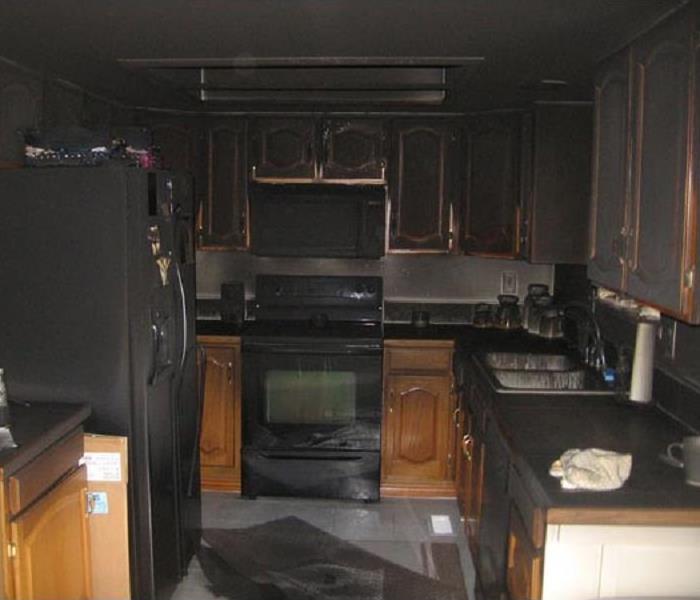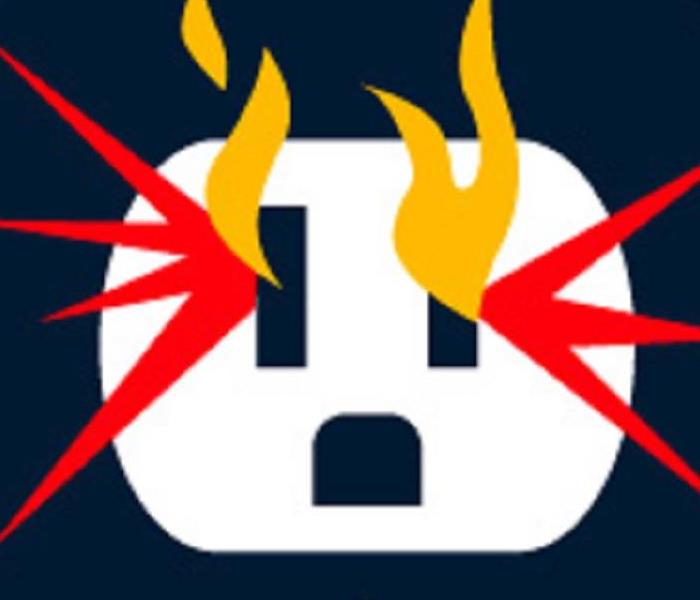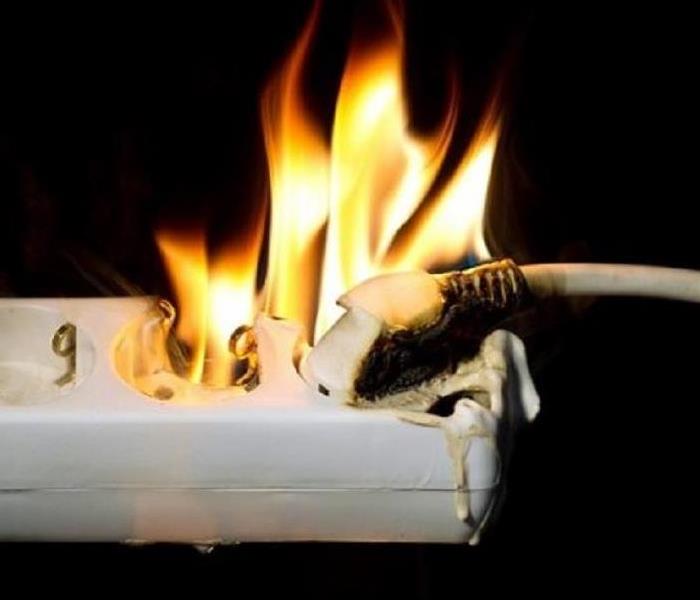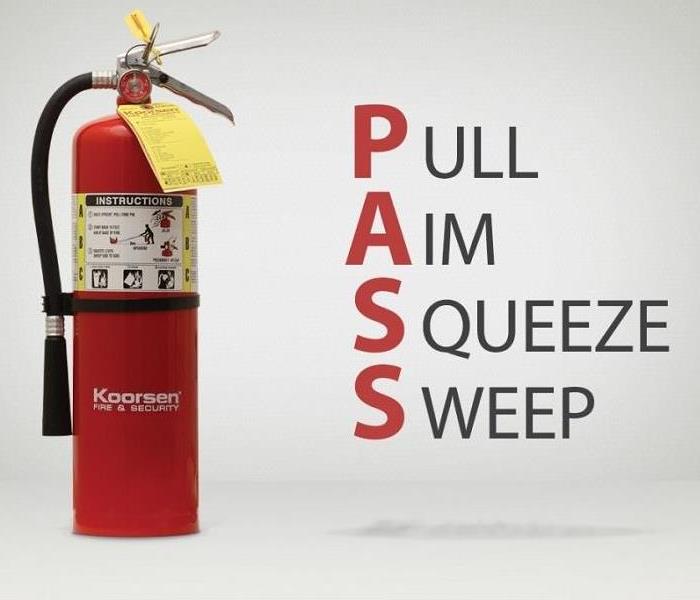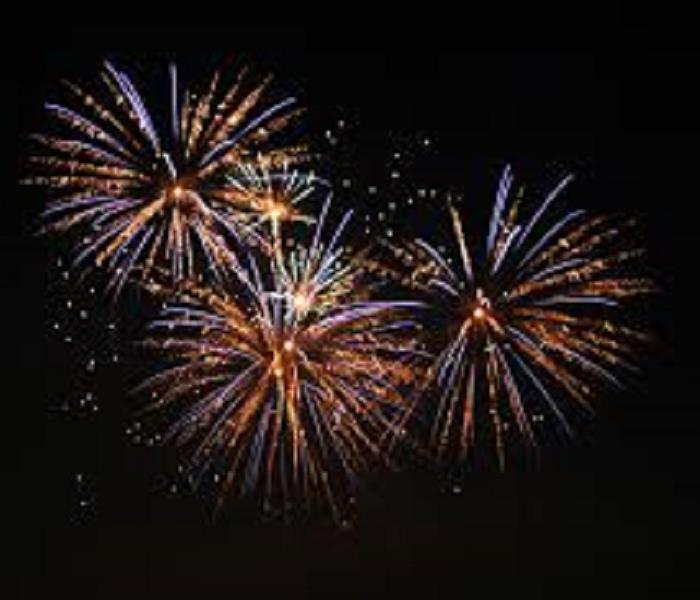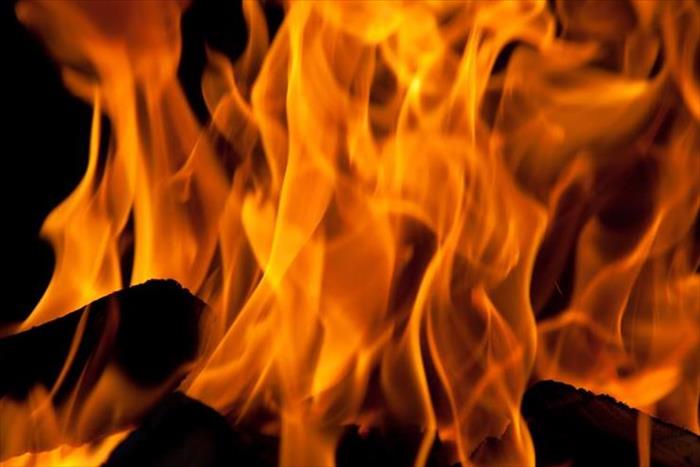Recent Fire Damage Posts
Restoring Contents in a North Syracuse Home After Fire Damage
6/21/2022 (Permalink)
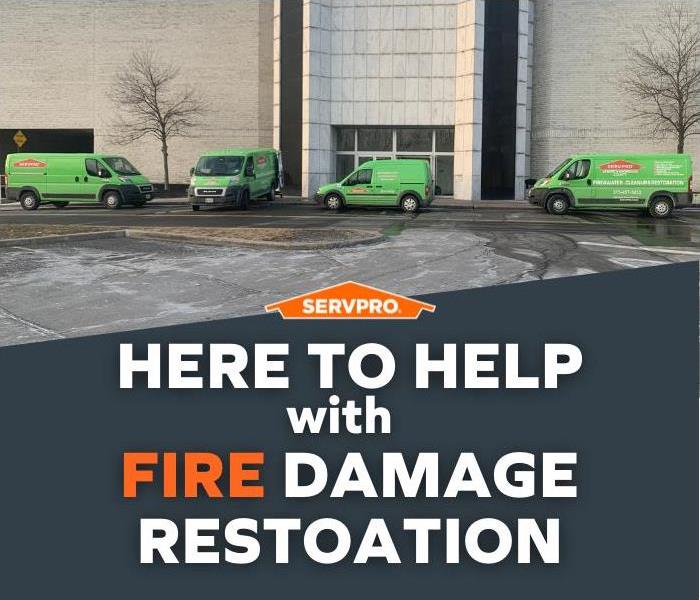 Fire damage and soot removal are cornerstones of SERVPRO's recovery for North Syracuse homes and businesses.
Fire damage and soot removal are cornerstones of SERVPRO's recovery for North Syracuse homes and businesses.
Cleaning by SERVPRO Eases North Syracuse Fire Repair
Fire causes devastating damage to contents by soiling, charring, or burning them partly or wholly. Considering the cost of replacing even one item is high, you can imagine buying several things simultaneously. The alternative is restoration, primarily through cleaning, which can save many items in your North Syracuse home. Below learn more about the cleaning products and methods available for such restoration.
Cleaning is a potent tool to help your North Syracuse home overcome fire damage effects. Since most fires that are stopped before they consume the entire property are managed in the early stages, the damage in most property sections is from smoke and radiating heat. The two aspects cause soiling and color shade changes, respectively. Unpleasant odors are also highly likely. SERVPRO can help you address any of these problems using advanced cleaning resources, making it "Like it never even happened."
Useful cleaning approaches:
- Dry cleaning
- Abrasive Cleaning
- Wet cleaning
- Foam cleaning
The variation in cleaning methods ensures that we only use a process if it is highly effective against the soils or blemishes and does not pose any dangers to the material of the item you want to be restored. Some methods also serve as a precursor to ease the execution of the other approaches. Dry cleaning is one such approach that is safe for almost any type of item. It helps halt deterioration such as etching or staining of surfaces. Our SERVPRO IICRC-certified technicians can perform dry cleaning using vacuums, feather dusters, or dusting cloths, removing soiling from electronics, furniture, and upholstery.
Restoring Oily Residues or Charring
Smoke can leave dry or wet residues depending on what burns. Proteins, oils, and synthetic materials produce oily residues when they combust. When such residue settles on other materials, cleaning it off without leaving blemishes is difficult. Another challenging issue to address is charring, which manifests as blackening or browning. Abrasive or wet cleaning are some practical approaches to dealing with stubborn soils. Wet cleaning introduces cleaning solutions that can contain acidic or alkaline chemicals that help break down the bonds fire residues form with surfaces.
Abrasive cleaning may be necessary for stubborn soils deposited on resilient materials. For instance, charred sections of wooden furniture require abrasive cleaning to remove the charred layer. Abrasion can come from physical force alone or special additives in cleaning products. For instance, liquid crème cleaners are cleaning pastes that contain abrading residues. They can be applied on a surface then when the area is wiped with a duster, the residue helps break down soils. Abrasive cleaning is not only reserved for furniture. Using other mediums such as compressed air, a jet of water, or special bubbles emitted by an ultrasonic cleaner, we can clear fire residues from different contents in your home.
Unique products for cleaning contents:
- Volatile dry solvents
- Dry cleaning solvents
- Upholstery and carpet cleaners
Even with all the resources to facilitate cleaning, saving all contents affected by the fire is impossible. Our SERVPRO technicians ensure you understand the dynamics of the situation you face. We inspect your contents and categorize them as salvageable, unsalvageable, or questionable. We only attempt restoration for the salvageable and questionable items.
SERVPRO of North Onondaga County can help you respond correctly to fire damage, especially when contents are significantly affected. You can reach us at (315) 457-3432.
Mechanical Actions Help Fire Restoration in North Syracuse Homes
5/5/2022 (Permalink)
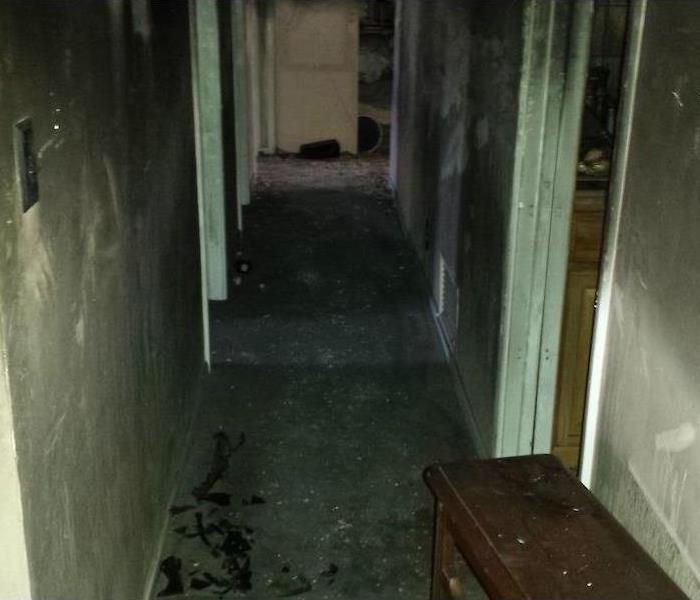 With advanced equipment, SERVPRO restores property to pre-damaged conditions, "Like it never even happened."
With advanced equipment, SERVPRO restores property to pre-damaged conditions, "Like it never even happened."
Fire Damage Cleaning in North Syracuse Properties Is Aided by Mechanical Actions
Cleaning up after a fire loss incident means having suitable restoration solutions for multiple rooms of the house simultaneously. Soot is considered among the most substantial obstacles, so our professionals respond rapidly to begin mitigating these scenarios as fast as possible. We’re Faster To Any Size Disaster, including post-fire damage recovery.
Types of Soot Cleaning
Fire restoration of North Syracuse homes focuses on how SERVPRO can handle overwhelming fire loss effects like soot particles. Partial combustion creates these hazardous solids, and they can heavily damage surfaces without direct action from our professionals. Soot cleanup can consist of several types of restoration, including:
- Dry Cleaning
- Wet Cleaning
- Abrasive Removal
What Are Mechanical Actions?
The term mechanical action describes physical efforts to help cleaning processes be more efficient. Many of these efforts focus on removing loose debris from the surfaces exposed to soot and smoke solids. The choice in this approach varies based on the severity of the damage to the material and the heap of soot solids to manage. Some of these options include:
- Vacuuming
- Brushing
- Scrubbing
- Pressurized Air Blasting
How Do Mechanical Actions Benefit Cleaning?
Incorporating these mechanical actions, regardless of the intended agitation, allows cleaning practices introduced against soot and smoke residues to be more efficient. Agitation is one of the primary elements of efficient cleaning production, along with temperature and contact time, so having a system in place to incorporate these efforts allows for the most natural cleaning possible for a property.
After a fire damage incident, cleaning a structure requires several techniques and multiple products. It is one of the truest showcases of the extensive experience and training our SERVPRO of North Onondaga County team receives. Our FSRT-Certified technicians are ready to help your home when you need it by calling (315) 457-3432.
What Does North Syracuse Home Fire Damage Restoration Take?
3/4/2022 (Permalink)
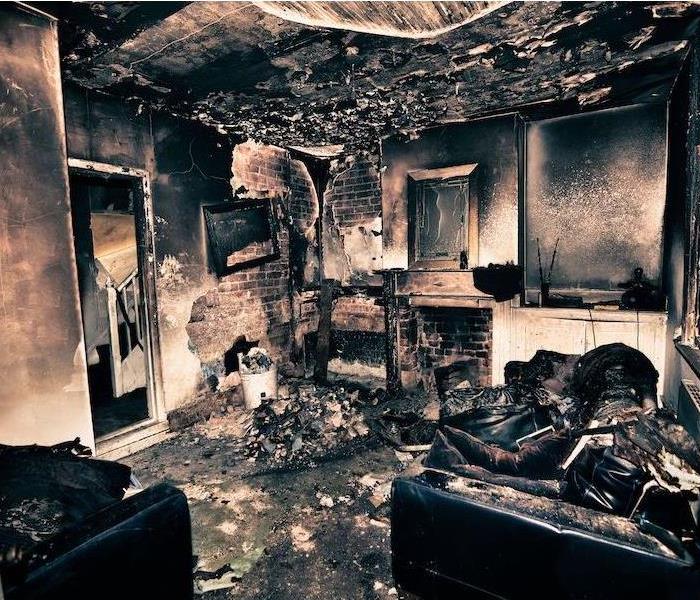 After a fire incident takes place. You can trust that your home is in good hands with the experienced technicians at SERVPRO.
After a fire incident takes place. You can trust that your home is in good hands with the experienced technicians at SERVPRO.
Better Product Choice from SERVPRO Aids Fire Cleanup in North Syracuse Property
With temperatures dropping during winter seasons, it is common to use space heaters at your North Syracuse home for some extra warmth. Despite the advantages, it also poses some disadvantages, such as fire risk, so take some precautions when using one. Ensure you do not leave it unattended and turn it off whenever you go to bed. You should also keep the heater at least 3 feet away from anything flammable like curtains and beddings.
A fire can still happen despite the precautions, so a fire damage restoration plan helps North Syracuse homeowners deal with the situation. Damage can extend to various structural components and items like clothes, rugs, nightstands, pictures, and paintings. SERVPRO helps in many ways, including inspecting the fire loss, cleaning debris such as soot, and deodorizing the affected areas.
Various Products Used for Content and Structural Cleaning
- Heavy-duty cleaners
- General surface cleaners
- Wood crème cleaners
Getting the Right Performance from Cleaning Solutions
Smoke can spread throughout the house, depositing soot to surfaces and items. This can affect the property and air quality if not removed fast. There are different kinds of soot, and some forms are easier to clean than others. The choice of cleaning product matters, and in some cases, general cleaning products are sufficient.
SERVPRO also uses unique products to dial in on specific cleaning needs such as stubborn soot. Soot can be tough to remove if it is greasy. Hence we use heavy-duty cleaners due to their high alkalinity level and ammonia content to strip it down. Controlling odor after cleaning is also essential.
Various Equipment Used by Deodorization Technicians
- Pressure/electric sprayer
- Ozone generators
- Air filtration devices
SERVPRO of North Onondaga County provides effective measures for fire damage restoration in your North Syracuse home. Call us at (315) 457-3432. We're Faster To Any Size Disaster.
Fire Restoration in North Syracuse Happens Fast With SERVPRO
1/20/2022 (Permalink)
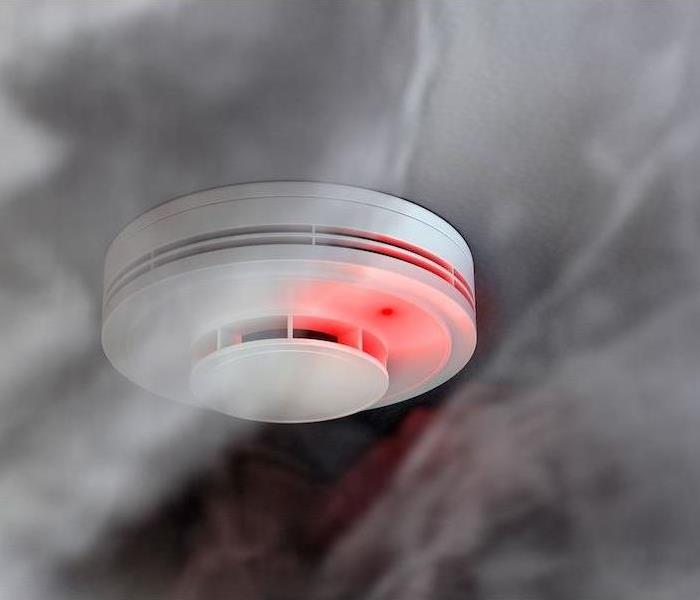 Let the experts at SERVPRO help restore the fire damage in your home.
Let the experts at SERVPRO help restore the fire damage in your home.
SERVPRO Can Handle Any Size Fire Restoration in North Syracuse
One of the biggest challenges in restoring a fire-damaged home is eliminating the odors left behind by burning material. SERVPRO's fire restoration experts in North Syracuse tackle the odor problem using a multi-step approach.
Once the SERVPRO techs identify the cause of the odor during fire restoration of your North Syracuse home, they use many kinds of deodorizing agents to neutralize it. Some of the most common deodorizers that we employ in domestic fire incidents include:
- Masking agents
- Pairing agents
- Adsorption and absorption filter agents
- Enzyme digesters
- Oxidizing agents
Apart from the masking agents, most other deodorizers alter the chemistry of the odor-causing molecule and render it odorless.
How Do SERVPRO Techs Use Pairing Agents to Deodorize Odors During House Fire Cleanup in North Syracuse?
Pairing agents are chemicals that chemically combine (pair) with odor-causing molecules. The pairing agents neutralize the odors in your smoke-damaged North Syracuse home in two principal ways:
- Absorbing the air-borne odor particles and causing them to precipitate onto surfaces where they can be cleaned up. An agent that can do this is called a humectant.
- Chemically combining with the odor molecules and changing their chemical properties make them odorless. A deodorizing agent that can do this is called a counteractant.
How Are Pairing Agents Applied During House Fire Cleanup?
A humectant pairing agent is usually applied after clean-up using a wet fogger that creates minute droplets of the deodorizer that can then absorb the odor-causing particles. A counteractant is generally applied by thermal fogging. In this process, the broken down into smaller particles using heat. Thermal fogging is especially useful to eliminate odors from difficult-to-reach places.
Call SERVPRO of North Onondaga County at (315) 457-3432; our techs are available 24/7 to answer your call.
Need Help with Removing Smoke Residue from a Fire in North Syracuse? Call SERVPRO
12/8/2021 (Permalink)
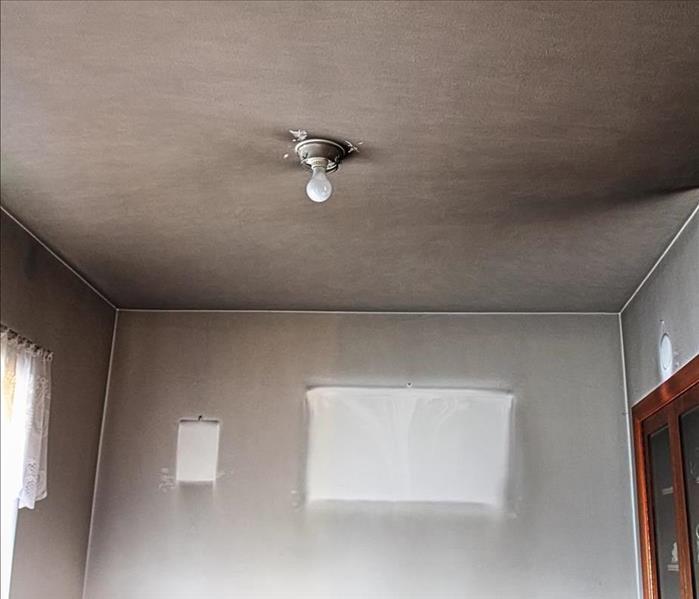 Fire damage and soot removal are cornerstones of SERVPRO's recovery for North Syracuse homes
Fire damage and soot removal are cornerstones of SERVPRO's recovery for North Syracuse homes
SERVPRO Provides Fire Damage Restoration and Repair Services in North Syracuse
Even small fires can produce a great deal of smoke and residue that coats everything in the immediate area of the fire. While the actual fire may not cause significant damage, cleaning smoke residues can be time-consuming. Residue from grease fires that produce oily residues vs. hot fires that produce light soot and dust must be cleaned carefully with the correct cleaning agents and materials.
SERVPRO provides fire damage restoration and smoke residue cleaning in North Syracuse residents. We cover everything from demolition and removal, cleaning and drying, to restoration and repair for fires of all sizes and types. Every fire is different, and the damage and restoration activity must be assessed and planned to ensure all expenses are kept to a minimum while restoring your home as fast as possible.
SERVPRO uses appropriate cleaning methods for each type of fire and smoke residue
- Dusting cloths dry or treated with mineral oil can be used to remove light soot and dust.
- Dry cleaning sponges can be used to remove loose soils, especially on dry smoke residues; however, they are not effective with greasy smoke residues causing smearing across the item's surface to be cleaned.
- Clean white towels are used to apply wet cleaning solutions and help to prevent streaking. They absorb and remove soils and moisture from the surface of the material being cleaned.
These are just a sample of the cleaning methods used by SERVPRO to remove smoke residues in your home. We analyze the type of fire, the residue produced, and we apply the appropriate cleaning method to return your home to its original condition, "Like it never even happened."
Call SERVPRO of North Onondaga County for fire damage restoration in North Syracuse and nearby areas. We can help 24/7. Call (315) 457-3432.
Need Fire Damage Restoration After a Small Fire – Call SERVPRO
11/1/2021 (Permalink)
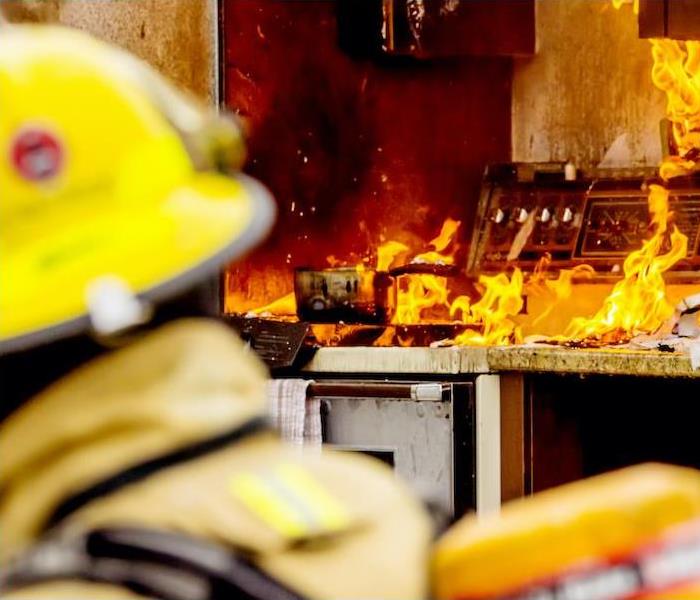 SERVPRO fire damage restoration technicians have the experience for any size fire damage to your home. No matter how small or big.
SERVPRO fire damage restoration technicians have the experience for any size fire damage to your home. No matter how small or big.
SERVPRO Provides Fire Damage Restoration Services to Residents of North Syracuse
Small fires can cause extensive damage to homes and their contents in North Syracuse. A burning cigarette dropped in the wrong place, or a candle tipped over can ignite loose papers, fabrics, and scattered materials. Most residents can extinguish these small fires quickly by smothering the fire or using a fire extinguisher. Unfortunately, even a small fire burning for several minutes can produce copious amounts of smoke. Fire extinguisher dust can cover everything. Your walls, furniture, floors, and contents must be cleaned, the odor removed, and smoke residues removed.
SERVPRO provides fire damage restoration for all types of fires in North Syracuse. All of your contents are cleaned and removed to another area of the home unaffected by the fire. These items remain in the staging area until your home is returned to its preloss condition.
Then, every square inch of the area impacted by the fire, smoke residue, and dust is cleaned. Our cleaning products have been carefully selected as the best to deal with the type of smoke residue deposited on your walls and floors.
SERVPRO responds to all types of fires, large and small, to provide restoration and repair services to our clients in North Syracuse. We train our team to deal with any fire damage. We utilize cleaning products that remove smoke residues caused by hot fires that produce fluffy smoke residue; grease fires produce oily sticky residues and odors; cool fires have lots of smoke residue, chemical fires, and more.
Our fire damage restorations services for all types of fires include:
Call SERVPRO of North Onondaga County for fire damage restoration in North Syracuse and surrounding areas. We can help 24/7. Call (315) 457-3432.
Is Fire Restoration Necessary to Make a North Syracuse Home Safe?
9/8/2021 (Permalink)
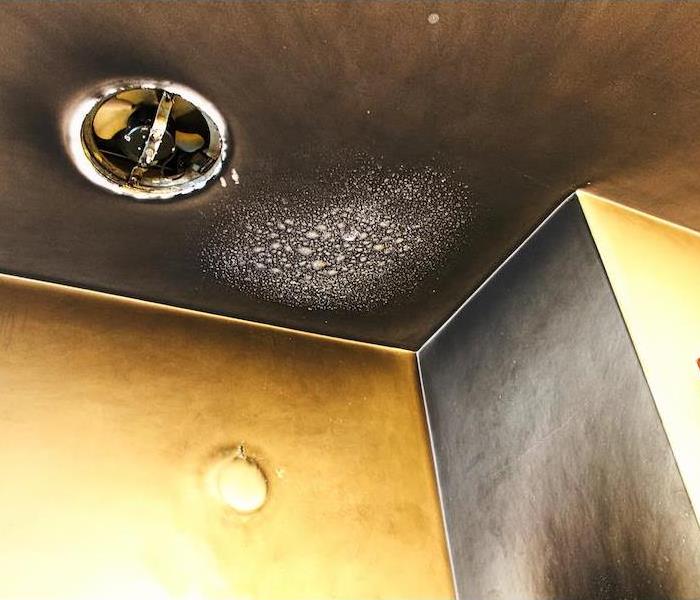 Fire damage restoration services for your home are an important choice. SERVPRO IICRC certified technicians are ready at a moment's notice. Call now!
Fire damage restoration services for your home are an important choice. SERVPRO IICRC certified technicians are ready at a moment's notice. Call now!
SERVPRO Fire Restoration Technicians Can Return your North Syracuse Property to a Safe and Secure Condition
Particulate contamination is one of the adverse effects of a recent property fire. Particulates, and volatile organic compounds (VOCs), describe the microscopic toxins, dust, and soot released from burning materials. With many common household materials having increasingly complex ingredients, the risk of particulate contamination is higher. Natural, organic material such as cotton, for example, leaves behind a relatively low-impact carbon dry soot. Polyester, one of the more commonly used materials for home draperies or fabrics, is built from a synthetic polymer and can release toxic particulates or VOCs into the indoor environment. SERVPRO can help with:
- Fire damaged homes
- Smoke remediation
- Fire and smoke damage restoration and cleanup
Conducting fire restoration in North Syracuse is a process of returning the home to a safe condition as it was before the fire. Managing particulate contamination is an essential part of this process. High pressure in a fire can lead to particulates bonding with or absorbing into clothing, draperies, fabrics, and mattresses. We have several methods that can help to decontaminate these materials before returning them to your home smoke, odor, and particulate-free.
- Exposure to ozone gases can break down organic and volatile compounds quickly through the process of oxidization. This technique is very useful for deep sanitizing clothing or fabrics exposed to fire gases.
- Professional-grade dry cleaning can help restore expensive natural fabrics, often employing solvents to break down or pair with particulates.
- Mechanical cleaning uses Esporta washing machines to suspend fabrics, while rotary jets apply natural wet cleaning to the fabric's surface. Automatic cleaning is capable of removing 99% of contaminants from cloth.
Tackling fire impact can be tough without access to professional-grade equipment and products. Contact SERVPRO of North Onondaga County for fire restoration at (315) 457-3432.
SERVPRO Can Help Limit the Effects of Fire Damage to North Syracuse Homes
6/30/2021 (Permalink)
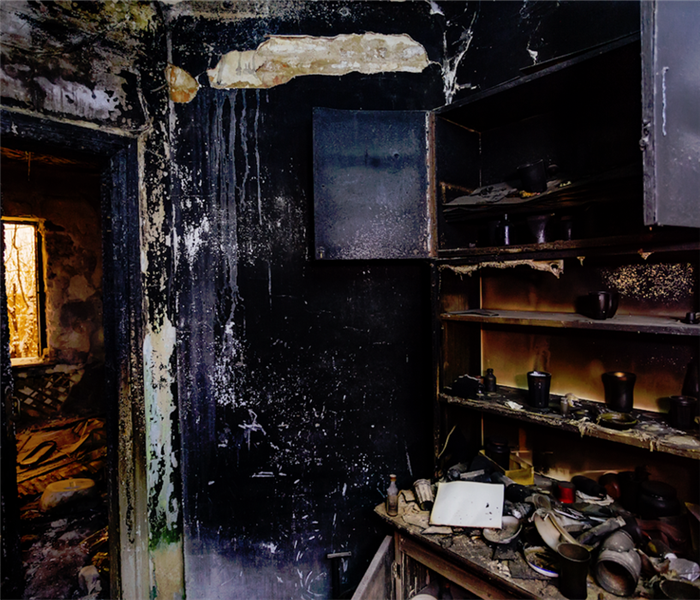 Whether it was soot or smoke that caused damage, team SERVPRO can help. Contact us for fire damage remediation services.
Whether it was soot or smoke that caused damage, team SERVPRO can help. Contact us for fire damage remediation services.
North Syracuse Property Owners Look to SERVPRO for Help With Fire Damage
The effects of fire damage to your North Syracuse home can be limited if you involve SERVPRO professionals as soon as possible. The longer the smoke and soot residue sits on a surface, the more difficult it gets to remove.
Every fire incidence is different, and SERVPRO techs use a combination of cleaning principles to clean up fire damage to your North Syracuse home. SERVPRO technicians use multiple ways to agitate surfaces, multiple products to produce chemical reactions, and multiple cleaning procedures to remove the residues. We utilize the complete range of restoration procedures before any fire-damaged material is declared unrestorable.
Principles of Cleaning SERVPRO Uses During House Fire Cleanup in North Syracuse Homes
Although the specifics may change with every fire situation, SERVPRO techs invariably use some basic principles during fire and smoke restoration of your North Syracuse home-
- Finding and identifying type of residue- Type of smoke and soot (dry or wet smoke residue, protein residue) involved determines the cleaning procedure to be used. SERVPRO techs meticulously identify the type of residue and surfaces involved and develop a cleaning strategy accordingly.
- Capturing and removing residues- Residues are captured by either vacuuming them or dissolving them in appropriate solvents to loosen the bonds with surfaces. The type of residue and the kind of surface determine which of these are used.
- Properly disposing of the residue- Once the residue is captured and removed, it needs to be disposed of safely. SERVPRO adheres to the guidelines set forth by the state and local administrations while disposing of the residue from fire-damaged homes.
Call SERVPRO of North Onondaga County at (315) 457-3432 for fire and smoke damage restoration.
Who Can Help Me With the Fire Damage in My Liverpool Home?
5/7/2021 (Permalink)
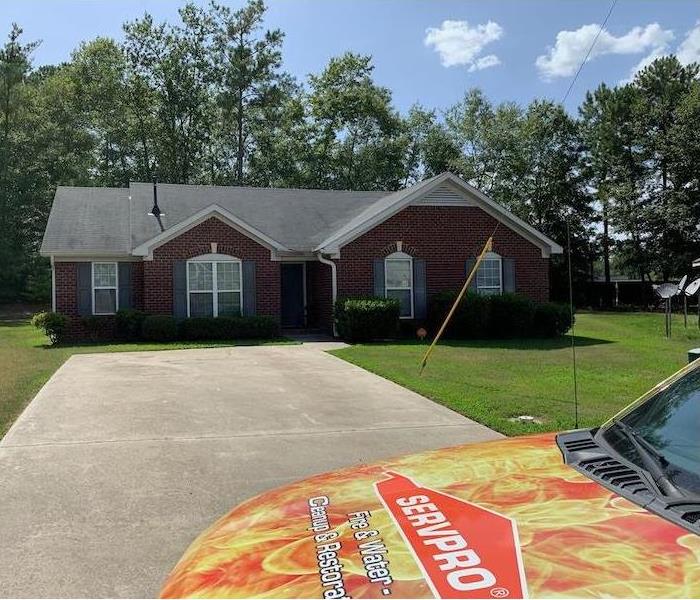 Day or Night, SERVPRO Can Arrive for Fire Damage Emergencies in the Liverpool Area.
Day or Night, SERVPRO Can Arrive for Fire Damage Emergencies in the Liverpool Area.
SERVPRO is Available 24/7 for Expert Fire and Smoke Damage Remediation
When fire damage strikes your Liverpool home, never wait too long for help. After a fire, visualize your kitchen in shambles. The walls are burnt and caked with smoke. The floor is a greasy mess and it is covered with water from emergency efforts. While this may seem like a daunting cleanup, we have your back here at SERVPRO.
If you quickly reach out for Liverpool fire damage restoration services, our technicians can always make an effort to reach you just as swiftly. To remediate the aforementioned example, our technicians could:
- Remove cabinetry and appliances
- Demolish unsalvageable flooring and drywall
- Set up advanced technology to help reduce moisture, malodors, and smoke damage
Our technicians are expertly trained and continue to take updated courses so we can say we have the best technicians around. We want to leave you feeling like you were in the best hands for the remediation process. Call us when you need:
- Water & Fire Damage Restorations
- House Fire Clean Up
- Fire Restoration
- Smoke Damage Remediation
If you find yourself needing fire and smoke remediation, get help today! Dial (315) 457-3432 to speak with SERVPRO of North Onondaga County. We can help you today!
What Methods Clean Smoke From Liverpool Walls?
3/17/2021 (Permalink)
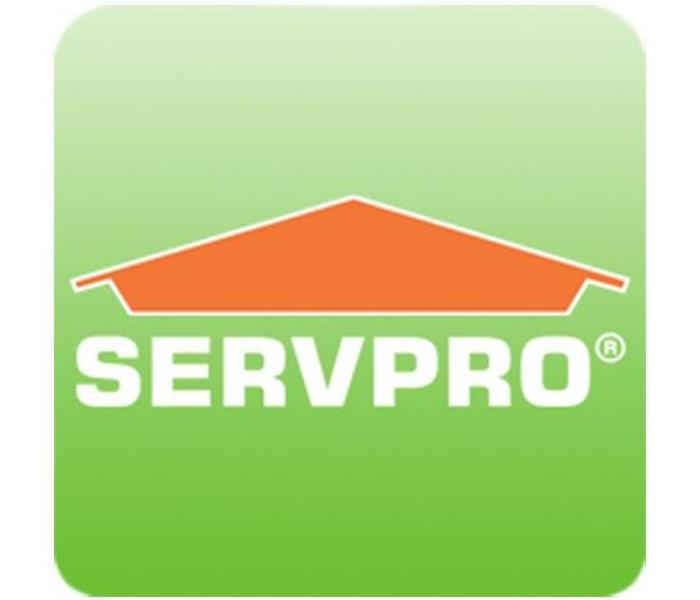 We understand the dangers of fire damages and the need for rapid response to your property. Call SERVPRO right away!
We understand the dangers of fire damages and the need for rapid response to your property. Call SERVPRO right away!
SERVPRO Helps Liverpool Residents with Smoke Damages after a Recent Fire
The village of Liverpool is a small residential town that borders suburban areas like Syracuse and Salina. The lakeside community of 2,347 people is part of the broader New York metropolitan area. The nearby Lake Onondaga, from which the wider county derives its name, was once a famous salt-producing region that grew the surrounding communities that manufactured salt and shipped it across the United States in the nineteenth century. Nearby Syracuse is fondly nicknamed the 'Salt City'; however, it was on Lake Onondaga's shores that the majority of salt production took place.
Early settlers to the region set up camp on Onondaga Lake in the early seventeenth centuries. At this point, the demographics of the area were primarily Iroquois indigenous peoples alongside a handful of French Canadian missionaries. The completion of the Erie canal in the area diversified the local population, with a large number of Irish, German, and Yankee settlers moving to the area in search of work. The industrial revolution in America saw a boom in many lake and waterside communities as these provided ideal power sources to run sawmills. The village was incorporated into the United States in 1830 when it changed its name from 'little Ireland' to 'Liverpool.' Local historians suspect the name change's driving factor was the UK Liverpool's strong reputation as a salt producer.
- The Salt Museum at Onondaga Lake Parkway is an exciting collection of exhibits and artifacts that charter the region's economic journey through salt mining. Run by the non-profit organization, admission is free, and there are several video watch-alongs documenting the processes and economic importance of salt-mining.
- The Onondaga Lake Park is one of the most sought-after spots in Liverpool, NY, on warm days. Alongside the scenic lake and landscape is a selection of facilities, butterfly enclosure, basketball, and volleyball courts. Several trails are available that run from five to ten kilometers in length.
- To live like a local in Liverpool, New York, you must attend a college basketball or football game. Upstate New York is famous for its love of SU games and, if you are unable to make it to the game, there are numerous atmospheric bars to catch it on. The Cobblestone, the Retreat, and the Barking Gull are a few of the local favorites.
SERVPRO Can Help Get Rid of Smoke Residues and Odors from your Liverpool Home
Fires produce smoke that can stick to walls, ceiling, interior cabinets, and fabrics. These particles are notoriously difficult to clean, and anyone's house fire can produce hundreds of chemical different smoke stains. SERVPRO technicians have extensive training and experience in assessing your home and finding the appropriate cleaning solution.
- Pre-testing involves light washing, dry sponging, and analyzing smoke deposits to inform the restoration project.
- Upholstery cleaning surfaces are available for a wide range of material fabrics, including leather, satin, and suede.
- Our dry cleaning services can remove clothes, sheets, and fabrics with smoke odor and return them to you in a preloss condition.
Make an informed decision on restoration. Contact SERVPRO of North Onondaga County at (315) 457-3432.
How Does Fire Restoration Work?
2/2/2021 (Permalink)
 After the flames are extinguished, call SERVPRO for fast fire damage remediation.
After the flames are extinguished, call SERVPRO for fast fire damage remediation.
SERVPRO Offers Liverpool Residents Detailed Fire Restoration from Start to Finish
Big or small, a fire in your Liverpool home brings immense destruction. Not only will there be varying levels of charred debris, but you also have to worry about corrosive, lingering soot, and smoke residue. Various materials throughout your home may not be salvageable. You have to ensure your entire interior gets the restoration you deserve, making this where our crew at SERVPRO comes in.
We tackle every aspect of the clean up through sanitization and finishing touches for fire restoration in Liverpool. In some instances, we may enlist the help of subcontractors to assist with fire damage recovery for areas such as:
- General construction or building experts to inspect areas of your structure where significant damage took place.
- Architects and remodeling professionals to help with fire emergency scenarios that are extreme.
- Electricians to ensure all re-wiring and re-circuit work is carefully taken care of to bring your home back to code.
Our fire restoration technicians can handle extensive cleaning along with associated drying and deodorizing needs. Fully IICRC-trained and certified, our team has the skills and experience to ensure your interior is left “Like it never even happened,” after the fire.
Call SERVPRO of North Onondaga County whenever you need us for fire restoration services at (315) 457-3432. We are Faster to Any Size Disaster!
SERVPRO Brings Fire Damage Restoration to Local North Syracuse Properties
12/16/2020 (Permalink)
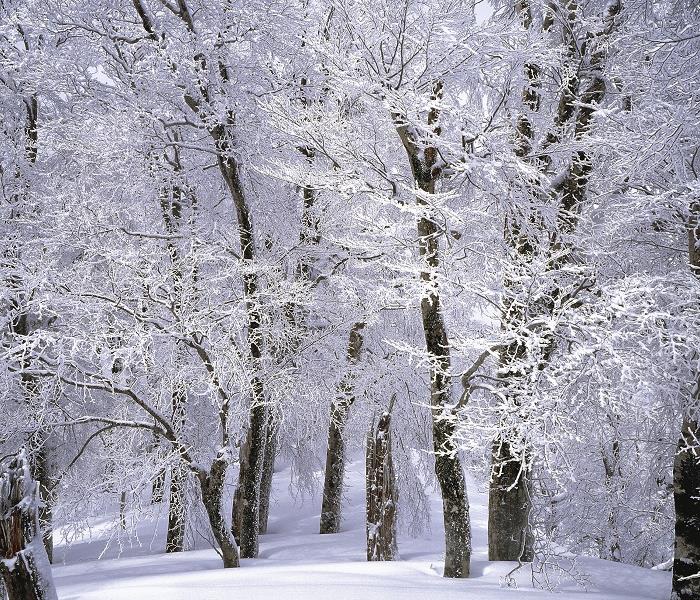 Syracuse receives more than 115 inches of snow each year, but no matter the weather, SERVPRO is always on call.
Syracuse receives more than 115 inches of snow each year, but no matter the weather, SERVPRO is always on call.
Local Syracuse Residents Know SERVPRO Is Ready to Handle Fire Damage Restoration 24/7
Although Syracuse is not the most populous city in New York, it is the fifth-largest. Called the economic and education hub for Central NY, this region has over one million residents. The city's name comes from the Greek city Syracuse, a town on the eastern coast of Sicily's Italian island, which also has salt pools and high saline lakes much like this area of New York.
Started and Continues as a Major Crossroads
At its inception, Syracuse began as a major crossroad between the Erie Canal and the branches. Then after the railroad came through, it became part of the network. Air travel is also convenient, and this city has the largest airport in the region.
Syracuse Has Humble Beginnings
In the 1600s, the Onondaga Nation's local indigenous population invited French missionaries to come work with them after meeting a few early settlers. The first mission got established on the northeast shore of the Onondaga Lake called Sainte Marie. The local tribes and the Europeans quickly set up a trade for furs and other necessities. This arrangement ended during the American Revolutionary War. The local Iroquois tribes were divided into two distinct groups. One group supported the British, and the other group supported the American patriots.
The original Syracuse was a loose gathering of several small villages and towns. To be a recognized township, the area needed two things: a post office and a name. The original idea for the town's name was Corinth, which was denied as it was already in use in another area of New York.
John Wilkinson would become the first postmaster and established Syracuse's name in 1820 based on a description in a poem he read about Syracuse, Sicily. This poem described the lake and salt springs that were also in the New York area he was tasked with naming.
Early Industry in Syracuse
The salt springs inspired some of the early industry. The first Solvay Process Company plant was established in Syracuse in 1884 by Ernest Solvay, who invented the ammonia-soda process to produce soda ash. Soda ash is also known as anhydrous sodium carbonate and comes from the brine wells in the area. Soda ash has numerous applications as a robust industrial cleaning agent. It can cut through grease, floor wax, and other hard to remove substances with ease. While this development creates many jobs and boosted industry in the area, it left Onondaga Lake as one of the most heavily contaminated bodies of water in the United States.
Industries reliant on the salt industry declined during the second half of the 1800s, but other manufacturing began, such as:
- The Franklin Automobile Company that produced air-cooled engines
- Smith-Corona Company
- Craftsman Shops that turned out finely made handcrafted furniture
Syracuse Climate
The area has a humid climate, and Syracuse receives more snow than any other metro area in the U.S., getting around 115 inches on average. The rainfall amounts are in line with the rest of the country at approximately 38 inches yearly, with September usually being the wettest month. The winters are cold, and the summers are hot and incredibly humid, with temperatures breaking the 100s are not uncommon.
Diverse Neighborhoods in Syracuse
The City of Syracuse has 26 neighborhoods within its established boundaries. The communities are good reflections of the historically ethnic and culturally diverse population.
Like many other New York cities, the city of Syracuse participates in the sister cities program. The sister cities are:
- Chiayi City, Taiwan
- Fuzhou, Fujian, People's Republic of China
- Taiz, Yemen
- Tampere, Finland
After signing up with the program, Syracuse students can trade and go to a sister city for two weeks; a student from the other city stays with a host family in New York to experience life and learn customs in America. The switches most often occur at the end of September or the first week of October each year.
Syracuse Fire Department
Until 1965, local volunteers made up the fire fighting force in Syracuse. Then, in 1965, the Syracuse City Fire Department got established, and the unit commissioned a 1946 Ford Pumper Truck to serve as the fire truck. The first fire chief elected was Keith West, who then appointed 25 volunteers who agreed to help when the siren sounded. At present, there are several firehouses around Syracuse, and each has state-of-the-art equipment, vehicles, and living quarters for the full-time first responders. They undergo rigorous training in the on-site facilities.
Can Soot-Covered Furnishings Get Cleaned Through Fire Damage Restoration in North Syracuse Homes?
When it comes to handling fire damage restoration in North Syracuse properties, the initial inspection is crucial. When SERVPRO technicians arrive, the techs quickly ascertain the items that show potential for cleaning and reuse and the articles that have too much damage from charring and smoke for restoration.
SERVPRO techs set up cleaning stations outside the worksite to handle the items removed from the home. The techs choose from among several different applications and solutions for the best outcome for each article. Non-porous items tend to fare the best as they do not absorb much of the airborne soot or smoke odors.
When cabinet surfaces or hardwood furnishings have damage post-fire, many considerations determine the potential for restoration, such as:
- If the furniture shows signs of heat damage
- Signs of water damage such as cracking or swelling
- Attempts made at cleaning before SERVPRO's arrival
The technicians have various professional cleaning agents specifically formulated for use on wood furnishings, countertops, and other surfaces that may need assistance in removing smoke damage after a fire. The techs are always extremely careful to test any items before cleaning to ensure the correct methods get chosen. This attention to detail assists in avoiding causing damage to items through incorrect cleaning methods.
SERVPRO of North Onondaga County at (315) 457-3432 brings the professional equipment and certified technicians to handle any type or size of fire damage restoration needed in North Syracuse properties.
Supporting the Art Community Around North Syracuse In the "New Normal"
11/2/2020 (Permalink)
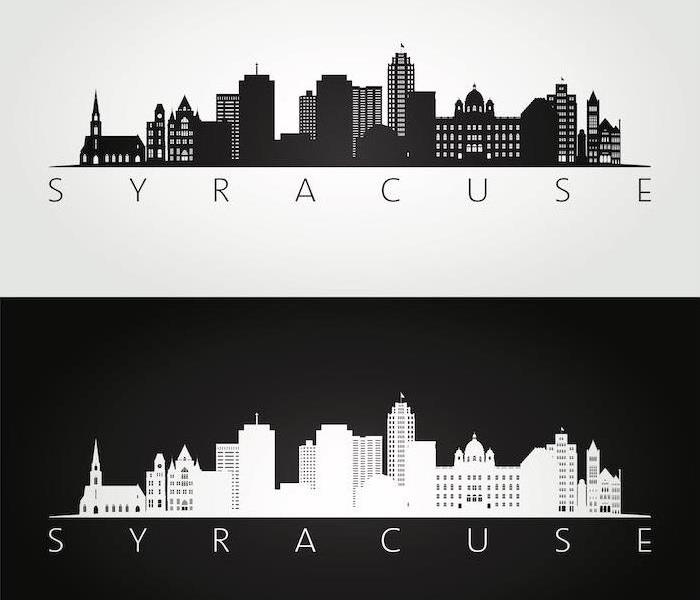 Don’t scoure the city when you need fire damage restoration, Call SERVPRO
Don’t scoure the city when you need fire damage restoration, Call SERVPRO
When You Live in North Syracuse, You can Support the Art Scene From Your Home
The shift of many of our activities to platforms such as Zoom and Skype has pros and cons. Even though we miss the in-person interaction, it has also opened a universe of opportunities not limited by distance or physical boundaries. For example, North Syracuse residents can now actively participate in Ithaca's Gallery Night without leaving their homes.
On the first Friday of the month, including November 6th and through dates into 2021, First Friday Gallery Night in Ithaca opens art galleries and other businesses to visitors walking through, and now you can also enjoy it virtually from 5:00 – 8:00 p.m. Whether you choose to drive to Ithaca or join virtually, you will support the local art scene and experience special performances while changing your week's monotony.
As part of the community, SERVPRO of North Onondaga County invites you to learn from the art experts just as you would call the experts in our team for fire restoration services. When you need us, all you need to do is call (315) 457-3432 and let us leave your home, "Like it never even happened."
Can Any Food Items Be Saved After a Fire in North Syracuse?
9/6/2020 (Permalink)
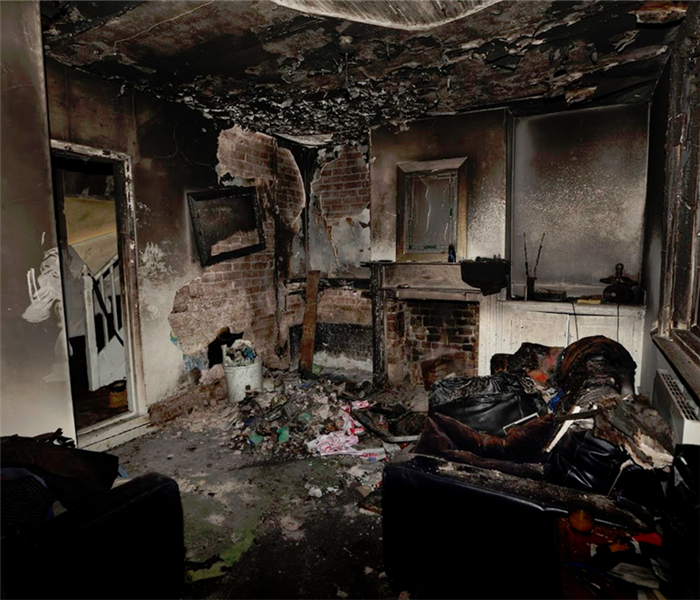 Fire damage in your home can be hard to clean up. Contact SERVPRO for professional remediation services.
Fire damage in your home can be hard to clean up. Contact SERVPRO for professional remediation services.
Heat Can Compromise Food Safety – SERVPRO in North Syracuse Can Help You Decide What Needs to Go
Whenever a house fire happens in North Syracuse, one of the main risks is trying to salvage food items that may be fire damaged. Tainted food cannot be saved, but our fire restoration technicians can help determine what has not been affected by the fire.
What Does High Temperatures Do to Food Items?
High temperatures can cause fire damage in North Syracuse to groceries even when the item looks undamaged. Contaminants may be present in what looks like a perfectly fine can of tomatoes or jar of peaches. Tiny cracks can develop in high heat that allows contaminants to enter the product. Extreme heat can cause sealed products to spoil later on, even though they are still “safely” sealed. Plastic containers can melt, or hazardous chemicals in the packaging can leach into the food as a result of intense heat.
What Additional Problems Can Occur with Food Items?
Smoke residue and soot can spread throughout a home quickly, even if the fire is contained to one room. Chemicals from fire extinguishers can contaminate boxed goods and fresh items. Anything left out like fruits and vegetables should be tossed. They cannot get washed and salvaged. Plastic wrap and cardboard boxes cannot protect food even if it hasn’t been exposed to the high temperatures. Soot contains any toxic material it came in contact with as the fire burned. These end up in food products that may look safe.
What About the Food in My Fridge?
Although your refrigerator has a seal to keep the cold air inside it may not be enough. If you refrigerator is still running, do not open it until our SERVPRO techs arrive. They can inspect the appliance and help you decide if the food inside is safe to eat.
It is always better to err on the safe side and throw any foodstuff out that is questionable. Our fire damage experts can help you make wise choices. Contact SERVPRO of North Onondaga County at (315) 457-3432 for professional fire restoration services.
Click here for more information about Syracuse.
How Do I Determine What To Save After Fire Damage Ravages My Liverpool Home?
7/7/2020 (Permalink)
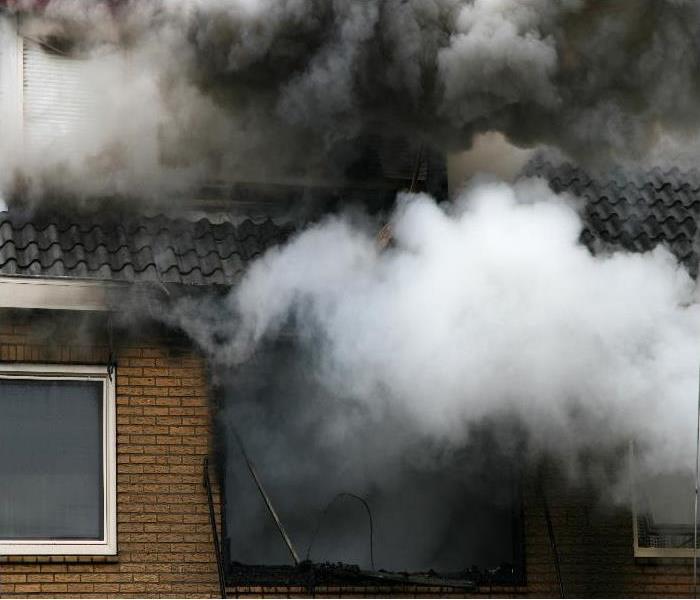 Assistance from a professional can help you make the right decision about salvaging items.
Assistance from a professional can help you make the right decision about salvaging items.
SERVPRO Helps Evaluate and Restore Fire Damaged Items Cost-Effectively in Liverpool
In the aftermath of a fire at your Liverpool house, you may have a hard time determining whether items should go directly to the disposal bin or whether there is a way to save them. Various aspects can influence the decision you make, including how the damage happens.
What aspects contribute to fire damage of items in Liverpool homes?
• Burning or searing by flames and heat
• Accumulation of residues
• Exposure to firefighting chemicals
• Oversaturation with water
Although fire sets the ball rolling, other things that happen during, or after the incident can end up damaging your valuables. For instance, heat and flames might have minimal effects on metal items. However, when residues like soot accumulate on their surfaces, and they remain untouched over extended periods, corrosion can develop, ruining the items. Our SERVPRO technicians in Liverpool are IICRC certified in fire and smoke restoration, so we can help take corrective steps to prevent secondary damage of salvageable items.
What level of resources should go towards saving items?
Although all items in your house have some value that you might want to preserve, it might not be feasible trying to save them all. Various considerations should be made before making the final decision. Our technicians consider:
• The cost of restoration compared to the value of the item
• The extent of damages
• Whether the item has sentimental value
Restoration procedures, whether it is regular or specialized cleaning, incur costs. Our SERVPRO technicians can help you make accurate evaluations, whether it is better to perform restoration or make replacements. Spending money and time restoring extensively damaged items, which can be readily replaced, is a waste of resources. For items with sentimental value, our technicians use a variety of cleaning techniques, including sophisticated ones such as soda blasting to deal with charring or stubborn residues.
Assistance from a professional can help you make the right decision about salvaging items. Call SERVPRO of North Onondaga County at (315) 457-3432 to help. We’re Faster to Any Size Disaster.
Grilling Safety Tips
7/29/2019 (Permalink)
During the summer months, we do a lot of grilling outside. It's important to remember a few safety tips to keep grilling fun and enjoyable.
First, keep the grill a few feet away from the house. If the grill gets out of control and a fire erupts, you don't want the flames to catch fire to the side of the home or any decking.
Use the grill in an open area. Do not use the grill where there is a ceiling, such as a covered deck area.
Keep the grill clean. If the grease tray gets too full, it makes it easier for it to catch fire. A grease fire can be very dangerous!
If you use a cover for your grill, wait until the grill has completely cooled before putting the cover on.
Lastly, don't walk away from the grill at any time. It's important to keep an eye on the grill so nothing happens.
First Responder Terminology-Fire Damage
6/26/2019 (Permalink)
There may come a time when you need to have a first responder help you become safe during an emergency situation. Here is some terminology you may hear from first responders and emergency personnel regarding a fire and what it means:
Class A fire – A fire involving combustibles such as wood, paper, and other natural materials.
Class B fire – A fire involving hydrocarbons (Petroleum and natural gas).
Class C fire – An electrical fire.
Class D fire – A fire involving metals, such as sodium, magnesium, potassium, uranium, lithium, and calcium.
Remember that if the cause the of the fire is known, they may use different techniques to put the fire out to get it out faster and causing less damage. It's important to give as much information as you know about a situation.
First Responder Terminology- Fire Personnel
6/26/2019 (Permalink)
When you call 911 to alert them of a fire, there are many people you may come into contact with throughout the situation. The following list explains some of those people and their duties. The people you work with during and after a fire can be overwhelming to remember everyone's name and positions, so we hope this is helpful!
Company – Two or more firefighters organized as a team, led by a fire officer, and equipped to perform certain operational functions. Compare with platoon and unit.
Company officer – A fire officer, typically a lieutenant or captain, who leads a team of two or more firefighters in a company.
Dispatch – Refers to a person or place designated for handling a call for help by alerting the specific resources necessary.
Engineer – A firefighter responsible for driving the engine to the scene of the call and operation of the pumps on an engine, to provide enough water to the firefighters on the hose. The term may be either a position title or a rank; usage varies among departments (also a Chauffer).
Engine Company – A group of firefighters assigned to an apparatus with a water pump and equipped with a firehose and other tools related to fire extinguishment.
Fire inspector – A person responsible for issuing permits and enforcing the fire code, including any necessary premises inspection.
Fire marshal – Administrative investigative office for fire prevention and arson investigation. Has legal authority to enforce state and local fire laws.
Top causes of Fires in the Home
6/19/2019 (Permalink)
According to the National Fire Protection Association (NFPA), home fires are the leading cause of all fire deaths in the United States. For the most part, home fires are easily preventable.
Here are the top causes of home fires.
1.Cooking equipment. This may seem like a no brainer but believe it or not, cooking equipment is the leading cause of all home fires. Do not leave the stove or oven unattended while cooking. If you do need to leave the room, even for a second, make sure there are no flammable items such as dish rags,cookbooks, grease, curtains or paper products near your appliances. It’s always a good idea to keep a fire extinguisher in the kitchen as well, just in case.
2. Heating, the second most common cause of home fires. Most fires involving heaters are caused by portable space heaters. They may be nice and convenient but blankets, lint and other flammables can easily get caught in them. If you have to use a space heater, make sure there are no loose materials that could easily burn around it.
3. Smoking. Cigarette’s and their ashes can easily catch on curtains, bedding and clothing which can quickly result in an out of control fire. Many fires caused by smoking happen in the bedroom when someone falls asleep with a cigarette in their hand. If you must smoke, do so outside your home for the safety of everyone involved.
4. Electrical fires can happen for a variety of reasons. Here are the top four:
- Never remove the grounding plug on an appliance. Three pronged plugs exists on appliances that need extra power to operate. Get an electrician to install the proper outlet if you find this a problem in your home.
- Lamps and light fixtures. You should never install a bulb with wattage that is too high for a particular appliance. This will cause the bulb to overheat and in turn, catch the lampshade or other flammables nearby on fire. Another thing to avoid is covering your lamp shade or fixture with a cloth or paper. While it may look nice, it’s not worth the potential fire you may cause.
- Faulty cords and outdated appliances. Never use a cord that is worn or frayed. For this reason, you should also avoid running cords under rugs where they could become worn and go unnoticed for a long amount of time.
- Last but not least, outdated wiring. If your home is more than twenty years old, you may want to have a licensed electrician take a look at the wiring system. While replacing the system can get costly, it is nothing compared to a life or the belongings you could lose if the old wiring causes a fire.
Take the time to look around your house and ensure the safety of your friends and family by checking these common fire causes. Do you have a fire extinguisher? A working smoke alarm? How about a carbon monoxide detector? While it may seem tedious to check these items and think ahead, you will be able to sleep more soundly at night knowing that you and your family are safe.
Types of Fire Extinguishers
6/19/2019 (Permalink)
In order to understand why different fire extinguishers exist, first one needs to understand how a fire exists in general. Using the wrong extinguisher can even cause fires to re-ignite or spread in some cases.
The fire triangle is a model used to illustrate how fires start. The triangle includes 3 elements: oxygen, heat and fuel. Without these three elements, a fire cannot exist. Fire extinguishers are made to take away one or more of the three elements to cease the fire. Since there are different types of fuel involved in different fires, there are a variety of fire extinguishers one can use based on the source of the fire.
Dry Chemical is the most common fire extinguisher used today as it is effective on all types of fires and is most likely the one you have in your home or at your place of business. This type of extinguisher interrupts the chemical reaction by creating a barrier between the fuel source and the oxygen. This can be used on Class A, B and C fires.
Dry Powder extinguishers are similar to dry chemical in that they separate the fuel from the oxygen or remove the heat element of the fire. They are only used for combustible metal fires (Class D) and are ineffective on all other types of fires.
Clean Agent or Halogenated extinguishers use halon agents and halocarbon agents to interrupt the chemical reaction of the fire. Clean agent is mainly used for Class B and C however, it can be used on Class A as well. There are concerns regarding contamination when these are used which brings us to the next type of extinguisher…
Water Mist extinguishers are a newer development and extinguish the fire by taking away the heat component. These are much safer than clean agent extinguishers as no halocarbon is involved and are primarily for Class C but may be used on Class A fires as well.
Cartridge Operated Dry Chemical interrupt the chemical reaction of the three components in the fire triangle and create a barrier between the fuel and the oxygen components when used on Class A fires. This extinguisher is also effective on Class B and C fires.
Wet Chemical extinguishers are unique in that they remove the heat component and prevent re-ignition by creating a barrier. These extinguishers are used for Class K fires which typically involve deep fryers and commercial cooking operations but may also be used for Class A fires in commercial kitchens as well.
Water and Foam extinguishers not only take away the heat element but the foam separates the oxygen from the other elements. These are used in Class A fires only and should never be used in Class B or C. If used in a B or C classified fire, there is a risk of spreading and not extinguishing the fire.
Carbon Dioxide fire extinguishers remove the oxygen first and secondly, remove the heat with cold discharge. They can be used on Class B and C fires but aren’t normally effective on Class A fires.
Fire extinguishers exist for your safety but if used improperly, may cause more damage. Make sure you know what kind of fire extinguisher you have and what types of emergencies it should and should not be used for.
Smoke Detectors
5/2/2019 (Permalink)
Did you know that the American Red Cross installs smoke detectors in homes for free? That's right! They believe that it's so important to have smoke detectors in the home to alert people of a fire that volunteers around CNY and Western NY have will provide free smoke detectors AND install them in your home at no cost! All you need to do is go to: https://www.redcross.org/local/new-york/western-and-central-new-york/about-us/our-work/home-fire-campaign.html and sign up.
We want you and your family to be alerted as soon as possible of a fire so that you can get out safely and call 911. Once the fire department has completely put out the fire and secured the area, you can call SERVPRO and we'll clean up any of the damage. We'll demo any structure that needs to be removed, clean and deodorize affected structure and contents, provide rebuild if necessary. We're here to help make your house a home again for you and your family!
Celebrate Summer Safely
7/25/2018 (Permalink)
Summer in Central New York is the time to enjoy the great outdoors! It is however, important to keep safety in mind. Please consider the following tips in order to enjoy being outdoors with friends and family in a safe way to keep you and your loved ones safe all summer long!
- When using charcoal grills, only use start fluids designed for BBQ grills. DO NOT add fluid after coals have been lit.
- When using a gas grill, ensure the hose connection is tight. You want to avoid having a gas leak which may cause a fire to ignite outside of the grilling area. Applying soapy water to the hose will easily help identify any leaks.
- When camping, always use a flame-retardant tent and set up any camp far away from the campfire.
- Always build a campfire downwind from the tent area.
- Clear any vegetation and dig a pit before building your fire.
- Extinguish the fire before leaving the site or going to sleep.
- Store liquid fire starters away from the tent area and only use dry kindling to freshen a campfire.
Steps to Take After Fire Damage
7/2/2018 (Permalink)
Fires can be understandably overwhelming. Here are the first steps to take after a fire.
- Make sure the local fire department has given the okay to go inside the residence.
- Call your insurance company so they can start a claim and initiate paperwork. If you are a tenant contact your landlord.
- Call loved ones to let them know you are okay and inform anyone who wasn’t home what happened.
- Secure the residence to prevent theft by locking doors and covering windows or holes. If you need help, give us a call! We offer board up services to secure the property.
- Get a copy of the fire report by contacting your local fire department.
- If the residence is uninhabitable, contact a friend or relative in the area to see if you can stay with them or the American Red Cross for assistance.
- Notify your employer, friends, family, post office, children’s schools, delivery services such as newspapers, utilities, telecom services and the police all of your current move.
- Consider the cleanup requirements. Does all of your contents need to be cleaned? Does every rooms need to be cleaned? Was the affected area contained to certain rooms in the home?
- Talk to your insurance company about what your policy covers before having a cleanup and restoration company come on site.
- If counseling is needed, especially for small children, don’t be afraid to seek help.
Grilling Safety Tips
6/18/2018 (Permalink)
Summer is finally here and we all know what that means…. grilling time! Who doesn’t love a nice steak or veggies cooked on the grill while basking in the sun? It’s easy to forget that while grills are a great way to cook food in the summer, there are some hazards that go along with them. Here are some tips to remember for safe grilling.
- Use your grill outside and away from low roofs. This will not only prevent toxins from lingering in your home but will also prevent potential fires.
- Place the grill on a flat surface away from anything that may catch fire such as trees, shrubs, fences and hedges.
- Do not grill with loose clothing or dangling bits that can catch fire or are flammable.
- Have a fire extinguisher on hand and know how to use it. It’s also a good idea to have a small squirt bottle fill with cold water nearby to douse any minor flames.
- Keep children and pets away from the grilling area.
- Do not leave the grill unattended.
- Smoke and char contain chemicals that have been linked to health problems including cancer. Do not stand over the barbeque and inhale the smoke if at all possible. While char stripes may look good on your steak, char has been known to contain cancer causing toxins. Cook the meat to your liking and then remove it from the grill before too much char builds up.
- Bristles from wire brushes have been known to get stuck on the grill and then people’s food which enters the digestive system causing abdominal pain. Use a different kind of nylon or plastic brush to clean your grill to ensure no one digests these harmful bristles. If you already use a wire cleaning brush or plan to continue using one, just make sure you check your grill before cooking to clean any bristles off.
Follow these simple safety tips for a fun and safe grilling season!
Fireworks Safety
6/18/2018 (Permalink)
When most people think of summer, particularly the Fourth of July, fireworks come to mind. While it’s best to just let the pros take care of bright light displays, we realize that many people often ignite their own fireworks. Here are some tips on how to stay safe while lighting off your own fireworks.
- Never let young children handle fireworks.
- Ensure older children are supervised closely by an adult when using sparklers and remind them to keep the sparkler away from their body, clothing, hair and others.
- Store fireworks in a cool damp place until usage.
- Do not use or buy illegal fireworks. These typically have names such as M-80, M-100, quarter pounder or blockbuster. Illegal fireworks account for the majority of accidents cause by fireworks in the first place.
- Never try to make your own fireworks.
- Read the labels on all fireworks before igniting so you are aware of safety precautions and performance of each.
- Do not carry fireworks in your hand or pocket as they could ignite due to friction.
- Never light fireworks in a metal or glass container.
- Wear protective goggles when lighting fireworks off or if you happen to be near the ignite site.
- Always have a bucket of water nearby and a hose just in case.
- Never reignite a dud. Wait twenty minutes and if it still hasn’t gone off, place it in a bucket full of water away from people, structures and flammables for several hours.
- Never point a firework at someone, even in jest.
- Ignite fireworks outdoors in an open space away from people, homes, brush and other flammable substances.
- Only light one firework at a time.
- Soak all fireworks in a bucket of water for several hours before throwing them away.
- Do not pick up firework debris until several hours after the display as many of pieces may still be hot and can cause burns.
Please keep these Safety tips in mind when setting off fireworks this season!
Types of Fire Damage
6/1/2018 (Permalink)
Not all fires are the same. They are caused by and thrive on different elements so, as a result, classes of fires came about. Classifications of fires are needed to determine how to extinguish them properly. You wouldn’t want to re-ignite or spread a fire by using the wrong type of extinguisher. Determining what class a fire is, is detrimental to using the proper equipment to extinguish it.
Class A involve ordinary combustibles such as paper, wood, plastics, cloth, trash and items that leave ash as a residue.
Class B fires are fueled by flammable or combustible liquids such as gasoline, propane, butane, paint and oil. Class B does not however include cooking oils or grease.
Class C are energized electrical fires which involve engines, transformers and appliances.
Class D fires are caused by combustible metals such as potassium, magnesium, titanium, sodium, and aluminum.
Class K fires are fueled by cooking oils, animal fat or grease. These normally occur in commercial kitchens.
In one of our previous blogs, you can read about the different types of extinguishers and which ones should be used for each specific class of fire.
Dryer Maintenance
4/16/2018 (Permalink)
There are many things in the home that should be checked on a regular basis to stop possible damage to your home. Have you ever checked your dryer vent to see if it is plugged? A plugged dryer vent could stop your dryer from running sufficiently and could possibly cause a house fire.
Dryers that are centrally located in the home are the most at risk of plugging up because the duct system is longer than ones that are located on an exterior wall of the home and vent directly to the outside.
Reasons for a dryer plugging up are:
- Excess lint build up. Over time, lint builds up in the dryer ducting and can cause a blockage. It’s important to unhook the ducting 1-2 times a year and thoroughly clean it out from any lint or debris that may be blocking it. If possible, you can simply use a vacuum and vacuum out the dryer ducting. However, if your dryer ducting is longer and is ducted through different areas you may need to have someone do this for you. Call our office and we’ll schedule an appointment to have your dryer ducts out for you! We have special equipment that can thoroughly clean all of the dryer ducts.
- Nesting pets. The dryer ducts can be a warm place for animals to borrow into. Animals may bring debris into the ducts to crate a home for themselves causing possibilities for fire damage. Checking that the ducts are not plugged will help ensure that this does not occur.
- Stuck exhaust hood flappers. From time to time, check the exhaust hood flap to ensure that it is not stuck.
Spring Fire Safety Tips
3/16/2018 (Permalink)
Spring Forward Safety Tips!
We recently moved our clocks forward an hour to get ready for spring and prepare for the warmer weather coming our way soon. This is the time of year we begin spring cleaning our homes, preparing to spend more time outside, doing repairs and refreshing our lives. This is also a great time to check things in our homes like smoke alarms, carbon monoxide detectors and fire extinguishers.
SMOKE ALARMS
According to the National Fire Protection Association Association, 3 out of every 5 home fire deaths result from fires in homes with no smoke alarms. Now is a great time to test your smoke alarm to make sure it still works and replace batteries if necessary. If your smoke detector begins making a chirping noise, that is a sign that you need to immediately replace it. The NFPA recommends having a smoke alarm in every bedroom and on each level of your home.
CARBON MONOXIDE DETECTORS
Carbon monoxide (CO) is an invisible, odorless gas that can have harmful affects on people and animals. CO alarms should be installed outside in a central location outside of bedrooms and on each levels of the home. Some smoke detectors are also CO detectors. Use the same rules for CO detectors as you use for smoke alarms, check that they are working and check their batteries.
FAMILY EMERGENCY PLAN
Now is also a great time to review your family emergency plan with the people who stay in your home. It’s good to remind everyone of the plan and make sure everyone is on board. Should any changes be necessary to the plan, now is a good time to discuss that as well.
EMERGENCY KIT
Because we never know when disaster may strike, it’s important to have an emergency kit in your home and car. During your spring cleaning, check to see if any supplies need to be restocked or replaced in your emergency kits.
Facts About Smoke and Soot
3/1/2018 (Permalink)
Smoke and Soot Damage Can Cause a Pervasive Odor in Your Home.
Smoke and soot is very invasive and can penetrate various cavities within your home, causing hidden damage and odor. Our smoke damage expertise and experience allows us to inspect and accurately assess the extent of the damage to develop a comprehensive plan of action.
Smoke and soot facts:
* Hot smoke migrates to cooler areas and upper levels of a structure.
* Smoke flows around plumbing systems, seeping through the holes used by pipes to go from floor to floor.
* The type of smoke may greatly affect the restoration process.
Different Types of Smoke
There are two different types of smoke–wet and dry. As a result, there are different types of soot residue after a fire. Before restoration begins, SERVPRO of North and East Onondaga, and Oswego Counties will test the soot to determine which type of smoke damage occurred. The cleaning procedures will then be based on the information identified during pretesting. Here is some additional information:
Wet Smoke – Plastic and Rubber
* Low heat, smoldering, pungent odor, sticky, smeary. Smoke webs are more difficult to clean.
Dry Smoke – Paper and Wood
* Fast burning, high temperatures, heat rises therefore smoke rises.
Protein Fire Residue – Produced by evaporation of material rather than from a fire
* Virtually invisible, discolors paints and varnishes, extreme pungent odor.
Our Fire Damage Restoration Services
Since each smoke and fire damage situation is a little different, each one requires a unique solution tailored for the specific conditions. We have the equipment, expertise, and experience to restore your fire and smoke damage. We will also treat your family with empathy and respect and your property with care.
Have Questions about Fire, Smoke, or Soot Damage??Call Us Today – (315-457-3432)
Your Belongings After Fire Damage
2/19/2018 (Permalink)
When you experience a fire in your home, the fire damage affects not only the structure of your house, but also your belongings. SERVPRO is here to help! SERVPRO understands your furniture, clothing, keepsakes and belongings are very important to you. We know that some of these items are essential to making a house a home.
After experiencing a fire, it is common to feel overwhelmed. We are here to make this awful situation better for you. SERVPRO offers a Contents Claim Inventory Service, this provides a detailed and accurate list of your belongings. Our technicians go room to room documenting your contents by creating a list and taking digital photos. This way, the lists and photos can easily be sent to you and your insurance company. Once the list is created, a preload value of contents can be created. This will help produce a detailed and accurate report to settle your insurance claim quickly and accurately.
When necessary, SERVPRO can complete move-outs and pack-outs for you! If your home requires extensive restoration or cleaning due to the damage from the fire, we can organize an efficient move-out of contents from the affected area. Move-outs allow for a quicker rebuild/remodeling and protects contents from damage during the remodel. While the rebuild/remodeling happens, your items can be inventoried and cleaned at our office. Should the remodeling take extra time, we can store your items until the project is finished.
When the restoration project is completed, we will move everything back into your home and help you get settled.
Different Types of Smoke
11/2/2017 (Permalink)
Did you know that there are actually different types of smoke which can cause damage to your home and contents during a fire? When we access the damage caused by fire and smoke, we take into account the cause of the fire and the type of smoke damage. This way, we make sure that the proper cleaning supplies and techniques are used to clean the fire and smoke damage. Just like there are different methods you would use to get a stain out of your favorite shirt based on what kind of stain it is, we use different cleaning methods based on what kind of smoke caused the damage to your home and contents.
Wet Smoke is occurs when plastic and rubber burn. The fire most likely burned at a lower temperature than other types of fire and leaves a very strong, pungent odor. Wet smoke leaves a sticky residue. There are often smoke webs in the corners that can be difficult to clean.
Dry Smoke often occurs when paper and wood burn. These materials burn quickly and at very high temperatures. The smoke rises and can cause a lot of damage to the ceilings and even higher levels that were not directly affected by the fire itself.
Protein Fire Residue occurs from evaporation of material rather than an actual fire. This type of smoke can be hard to see, but causes a discoloration or paints and varnishes. Protein fire residue has a very strong odor which can be hard to get rid of.
Fuel Oil Soot often happens when a furnace has a “puff back”. This is caused when a furnace malfunctions and the HVAC system throws smoke throughout the home by way of the duct system. The furnace will need to be replaced or repaired before cleaning can begin to ensure that the problem does not occur again. A duct cleaning will also need to be performed so that left over soot in the ducts doesn’t get thrown around the affected areas again.
No need to worry about figuring out what type of smoke damage you have, our SERVPRO team will assess the type of smoke that has affected your property and decide what cleaning methods will be the best.
Maintaining Your Electric System
8/5/2017 (Permalink)
Each year many fires break out in homes and commercial buildings due to a failure in the electrical system. While not every electrical fire can be prevented, there are precautions which can be taken to lessen this risk.
Electrical fires can be caused by:
- Broken wires
- Wire insulation drying out
- Loose switches or receptacles
- Overheating caused by dirt an oil
Allstate Insurance company recommends that you have your electrical system checked by a licensed electrician every four years. Having an electrician assess the electrical system will ensure that your home or building is up to code and that any issues are addressed. If you see an appliance that has a broken wire, fix the wire immediately or replace the appliance. While replacement may be costly, it will reduce the chance of a fire. Tighten any switch or plug that appears loose. It is important that switches and plugs are secure. Remember not to overload outlets. If necessary use an electrical adapter with surge protection.
Studies show that faulty wiring is the number 1 cause of electrical fires. Watch for warning signs of faulty wiring:
- Flickering lights
- Breakers that always trip
- Fuses that blow
- A burning smell when appliances are plugged in
- Outlets/switches that spark when plugging in or unplugging an appliance
- Discoloration around outlets
Remember that prevention is the key to safety! Electrical fires spread quickly and can be life threatening and costly. Call your local electrician if you have specific questions or concerns about something in a home of building that you own. Working with electrical work can be very dangerous and it is important to hire an experienced technician to complete any necessary electrical work.
Fireworks Safety
5/26/2017 (Permalink)
Who doesn’t love fireworks in the summer time? While it is so much fun to enjoy fireworks light up the night sky, it is important to be safe! Please read these safety tips to ensure you have a fun, safe night!
Safety Tips:
-Check to make sure that fireworks are legal in your area before buying and using them.
-Read instructions for proper use of the fireworks thoroughly before use.
-Do not allow young children to play with fireworks unsupervised.
-Do not hover directly over the fireworks at any time when lighting the fuse.
-Do not attempt to re-light fireworks that didn’t ignite on the first try.
-Keep water easily accessible in case of a fire or other accident.
-Do not point fireworks toward another person.
-Do not consume alcohol when using fireworks.
Facts about Fireworks:
-Sparklers are 15X’s hotter than boiling water.
- Approximately 200 people go to the ER everyday from June 17th-July17th with injuries related to fireworks.
-People ages 25-44 make up 40% of injuries reported from fireworks.
- There are 2X’s as many fires on July 4th than reported any other day of the year.
Have fun, but remember to be safe!
Electrical Safety
5/16/2017 (Permalink)
Did you know that May is Electrical Safety Month? We would like to give you some electrical safety tips which could help you avoid fire in your home! Between 2007and 2011, 48% of home fires caused by electrical failures were because of distribution errors. This means that the electric usage in the home was at an unsafe level, causing fires to start due to overloading the system.
Items in your home that you should check the wattage of to ensure they are not being overloaded are:
-Bulb wattage- ensure that you are using the correct wattage in lamps and fixtures
- Cords- replace any frayed, cracked or damaged cords as soon as possible
-Extension Cords and Power Strips- Do not over load! Only plug in one high-wattage appliance per power strip
-Outlets- if the outlet feels warm, this is a signal that the wiring is unsafe and should be checked out by a professional
-Appliances- Unplug any unused appliance
-Fuse Box-Make sure the fuses are the correct size for the circuit
-Circuit Breaker Box- Occasionally turn the circuit breakers off and on to make ensure they are in good working condition.
Should you have any questions, don’t hesitate to contact an electrician to check out the electrical situation in your home. They are happy to come out and inspect your home for any improvements that can be made. It is important to make sure your house’s electrical system is up to code for the safety of you and your family.
Most Reported Causes of Fire
3/14/2017 (Permalink)
The National Fire Protection Association lists the frequency of reported fires by causes on their website. The following are the most frequently reported fires:
Appliances and Consumer Electronics- This list includes but is not limited to cooking equipment, heating equipment, washers and dryers, air conditioners and fans.
Child Play- Approximately 44,500 fires are started each year by children playing with matches, lighters and other fire starting materials not even knowing the dangers this type of play can cause.
Candles- Placing candles in places where they can easily catch fire and leaving them unattended.
Chemicals and Gases- Storing gases improperly and spontaneous combustion.
Holidays- Christmas trees, holiday lights and decorations.
Weather and Outside Elements- Such as lightening, brush, grass and trees.
Smoking Materials- Cigarettes and other smoking supplies.
It is important to take notice that many of the commonly reported causes of fires are preventable to some amount. It is important to take caution when utilizing anything that could have potential to start a fire. Some of the actions seem harmless, such as going to take a shower while baking in the oven. However, fires often start when we least expect it. It is better to be safe than sorry. For more information about fire visit: http://www.nfpa.org/news-and-research/fire-statistics-and-reports/fire-statistics
Removing Odors From Smoke Damage
2/28/2017 (Permalink)
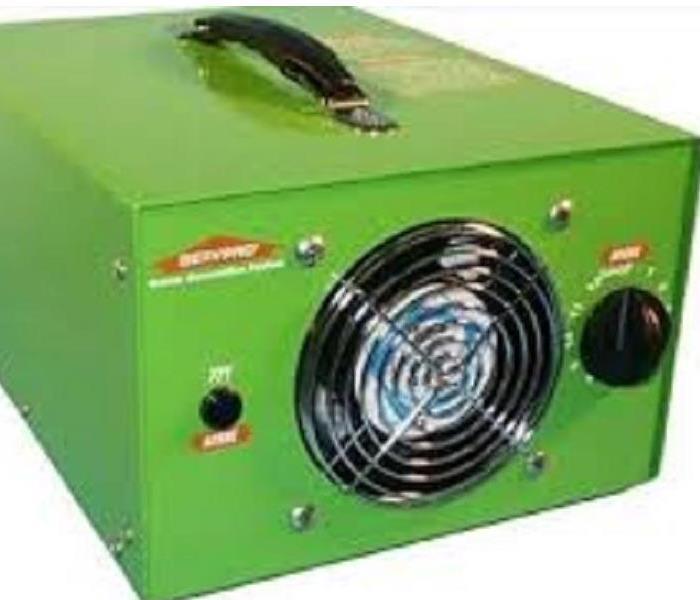 Ozone Generator
Ozone Generator
After a fire, you may have a strong residual smoke odor even after a full cleaning has been performed. Smoke odors can penetrate materials and get in hard to reach crevasses. In order to completely remove smoke odor we have an Ozone Generator that is used to oxidize odor. In addition to smoke odor, this Ozone Generator can be used to eliminate odors from pets, mildew, organic pollutants and more without the use of chemicals.
This Ozone Generator does not leave any residual film. All people and animals should vacate the area while the ozone machine is being used in. We seal the room to prevent dissipation to areas that do not need deodorization.
We recommend customers having their contents and structure ozoned following fire restoration to ensure all odors are removed.
Recently a fire broke out at a local business, Salt City Billiards, during the very early morning. (http://cnycentral.com/news/local/early-morning-fire-at-salt-city-billiards-in-north-syracuse) Many of the customers who play pool at this location had their pool cues and cases stored on-site at Salt City Billiards. The pool cues and cases can be very expensive and absorbed a good amount of smoke odor. We told the customers that they could bring their pool cues and cases to our office and we would put them in our ozone room free of charge to remove the odor.
How to Use a Fire Extinguisher
1/18/2017 (Permalink)
Do you have a fire extinguisher in your home or business? Did you know that many insurance companies offer a discount for having a fire extinguisher in your home? For a mere $20-$50 you could save money on your homeowners insurance and have a life and property saving tool in your home.
If you have a fire extinguisher in your home, it is important to understand how to properly use it. After reading this article read the instructions on your extinguisher and become familiar with where everything is located on it. Make sure to share the information with everyone in your home so they too can be prepared.
The National Fire Protection Association recommends remembering the word PASS in order to properly operate your extinguisher.
Pull the pin. Hold the nozzle pointing away from you and release the locking mechanism.
Aim low. Point the extinguisher at the base of the fire.
Squeeze the level slowly and evenly.
Sweep the nozzle from side-to-side.
Make sure you store your fire extinguisher in a safe and easily assessable area. Check the date on your extinguisher and make certain it is not expired. Put in your calendar to check the expiration date yearly.
Before purchasing a fire extinguisher, visit NFPA.org to understand which type of extinguisher is right for your property.
Thanksgiving Safety
11/8/2016 (Permalink)
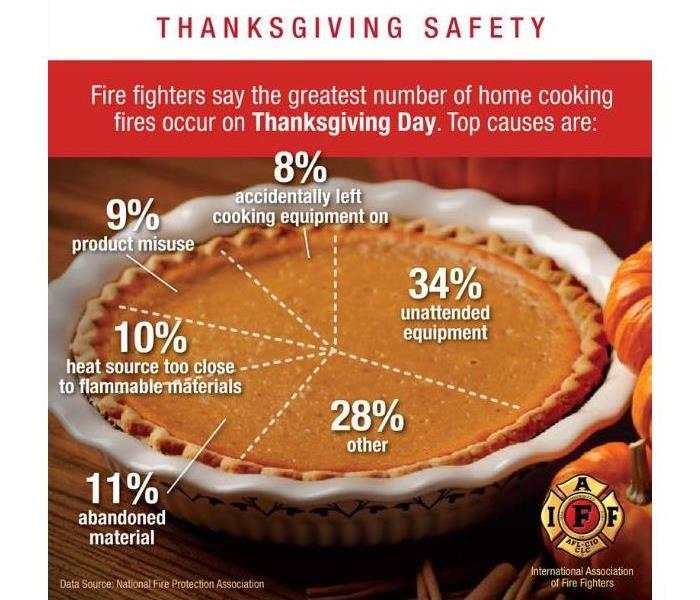 This information is from the National Fire Protection Association.
This information is from the National Fire Protection Association.
Did you know that Thanksgiving is the leading day of the year for home fires involving cooking equipment? Follow these tips to ensure that you can enjoy the holidays with family and friends eating delicious food and thinking about what you’re most thankful for!
- Pay attention! Don’t get distracted by having too much going on at once. Keep a close eye on everything you have cooking and never leave the kitchen unattended.
- Don’t cook while intoxicated. Although the holidays are a time to relax and let loose, make sure you do not have too much to drink while cooking/baking.
- Keep a lid handy to smother the flames. Fires can start very quickly. Make sure you’re prepared any event that may erupt.
- Do NOT pour water on a grease fire. Water may be your first thought to put on any fire, but for a grease fire it will not help. If possible, you can cover the grease fire to attempt to remove oxygen from the flame. Pouring baking soda on the flames will also help deprive the flames of oxygen and put out the fire.
- Consider purchasing a smart stove which will extinguish fires or turn off automatically by itself. It is amazing what technology has been developed! There are many different types of smart stoves which have many different functions. Some of which you can connect remotely to your cooktop and oven to control the settings remotely.
- Keep flammable items away from the stove top. This may seem obvious, but when you are trying to make 3 things at once, it can be easy to set something down on or near the cooktop that shouldn’t be there.
- If you do have any type of fire while cooking, make sure to call your local fire department. After a material has been on fire the objects stay very hot for a long time. Sometimes the fire can restart. The fire department can ensure that the items are cool enough that the fire won’t restart.
We hope you remember these tips all year long! Hope you have a safe and happy holiday with your friends and family!
What's the First Step After a Fire?
8/4/2016 (Permalink)
Fires can be understandably overwhelming. Here are the first steps to take after a fire.
- Ask the firefighters or proper authorities on the scene if it is safe to go inside the residence.
- Call your insurance company so they can start a claim and initiate paperwork. If you are a tenant contact your landlord.
- Call loved ones to let them know you are okay and inform anyone who wasn’t home what happened.
- Secure the residence to prevent theft by locking doors and covering windows or holes. If you need help, there are numerous companies that offer these services.
- Get a copy of the fire report by contacting your local fire department.
- If the residence is uninhabitable, contact a friend or relative in the area to see if you can stay with them or the American Red Cross for assistance.
- Notify your employer, friends, family, post office, children’s schools, delivery services such as newspapers, utilities, telecom services and the police all of your current move.
- Consider the cleanup requirements. Is this a small fire or a large project you will have to hire a company for?
- Talk to your insurance company about what your policy covers before having a cleanup and restoration company come on site.
- If counseling is needed, especially for small children, don’t be afraid to seek help.
Firework Safety
6/29/2016 (Permalink)
When most people think of summer, particularly the Fourth of July, fireworks come to mind. While it’s best to just let the pros take care of bright light displays, we realize that many people often ignite their own fireworks. Here are some tips on how to stay safe while lighting off your own fireworks.
- Never let young children handle fireworks.
- Ensure older children are supervised closely by an adult when using sparklers and remind them to keep the sparkler away from their body, clothing, hair and others.
- Store fireworks in a cool damp place until usage.
- Do not use or buy illegal fireworks. These typically have names such as M-80, M-100, quarter pounder or blockbuster. Illegal fireworks account for the majority of accidents cause by fireworks in the first place.
- Never try to make your own fireworks.
- Read the labels on all fireworks before igniting so you are aware of safety precautions and performance of each.
- Do not carry fireworks in your hand or pocket as they could ignite due to friction.
- Never light fireworks in a metal or glass container.
- Wear protective goggles when lighting fireworks off or if you happen to be near the ignite site.
- Always have a bucket of water nearby and a hose just in case.
- Never reignite a dud. Wait twenty minutes and if it still hasn’t gone off, place it in a bucket full of water away from people, structures and flammables for several hours.
- Never point a firework at someone, even in jest.
- Ignite fireworks outdoors in an open space away from people, homes, brush and other flammable substances.
- Only light one firework at a time.
- Soak all fireworks in a bucket of water for several hours before throwing them away.
- Do not pick up firework debris until several hours after the display as many of pieces may still be hot and can cause burns.
Fireworks are illegal in many states so make sure you check your state and local laws before lighting up the skies. Happy Fourth of July!
Grilling Safety Tips
5/23/2016 (Permalink)
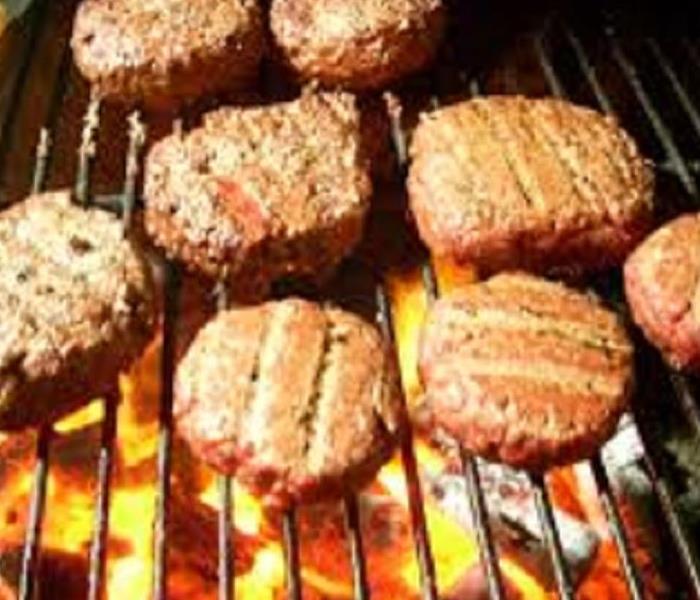 Grill
Grill
Summer is finally here and we all know what that means…. grilling time! Who doesn’t love a nice steak or veggies cooked on the grill while basking in the sun? It’s easy to forget that while grills are a great way to cook food in the summer, there are some hazards that go along with them. Here are some tips to remember for safe grilling!
- Use your grill outside and away from low roofs. This will not only prevent toxins from lingering in your home but will also prevent potential fires.
- Place the grill on a flat surface away from anything that may catch fire such as trees, shrubs, fences and hedges.
- Do not grill with loose clothing or dangling bits that can catch fire or are flammable.
- Have a fire extinguisher on hand and know how to use it. It’s also a good idea to have a small squirt bottle fill with cold water nearby to douse any minor flames.
- Keep children and pets away from the grilling area.
- Do not leave the grill unattended.
- Smoke and char contain chemicals that have been linked to health problems including cancer. Do not stand over the barbeque and inhale the smoke if at all possible. While char stripes may look good on your steak, char has been known to contain cancer causing toxins. Cook the meat to your liking and then remove it from the grill before too much char builds up.
- Bristles from wire brushes have been known to get stuck on the grill and then people’s food which enters the digestive system causing abdominal pain. Use a different kind of nylon or plastic brush to clean your grill to ensure no one digests these harmful bristles. If you already use a wire cleaning brush or plan to continue using one, just make sure you check your grill before cooking to clean any bristles off.
Follow these simple safety tips for a fun and safe grilling season!
The Most Devastating Fire in U.S. History
5/10/2016 (Permalink)
 Forest fire.
Forest fire.
The Great Peshtigo Fire
The Peshtigo fire was the most devastating fire in U.S. History to date killing more than 1,500 people and decimating 1.2 million acres in Wisconsin and upper Michigan. Little is known about the tragic fire of Peshtigo on October 8th of 1871 for two reasons: one; the Chicago fire eclipsed the Peshtigo in the news headlines and two; all of the town’s records were burned in the fire.
The direct cause of the fire is unknown but there is speculation that several contributing factors were at play. The slash and burn method was commonly used during this time period in the area to clear land for farming and railroads. The wood that was cut remained off to the side of the farmlands and railroads where it was left to dry up and created perfect kindling for the fire. It had been a hot, dry year and many of the water resources in the area had been dried up or were at dangerously low levels. No one knows for sure how the fire ignited but with the above mentioned factors combined, it is generally believe that strong winds blew and the smallest spark ignited the kindling all around the area. The intense wind and dry climate created a fire tornado which swept the affected area, even jumping across the Peshtigo River. The fire burned through 16 towns and the city of Peshtigo was gone in an hour.
There are theories that a comet or meteorite may have hit the Earth on October 8th, 1871 causing both the Peshtigo Fire and the Chicago fire but most scientific research says otherwise. One other far-fetched tale is that of a cow tipping over a lantern to start the fire. A more realistic assumption is that the railroad workers caused a spark which ignited the brush or a spark flew from a train passing through igniting the brush around the tracks. We may never know the true cause of this horrific fire. The only safe haven during the catastrophe was the Peshtigo River. Today there is a museum and research center in downtown Peshtigo to remember the fire, the damage it caused and those who lost their lives in it.
Classes of Fires
2/16/2016 (Permalink)
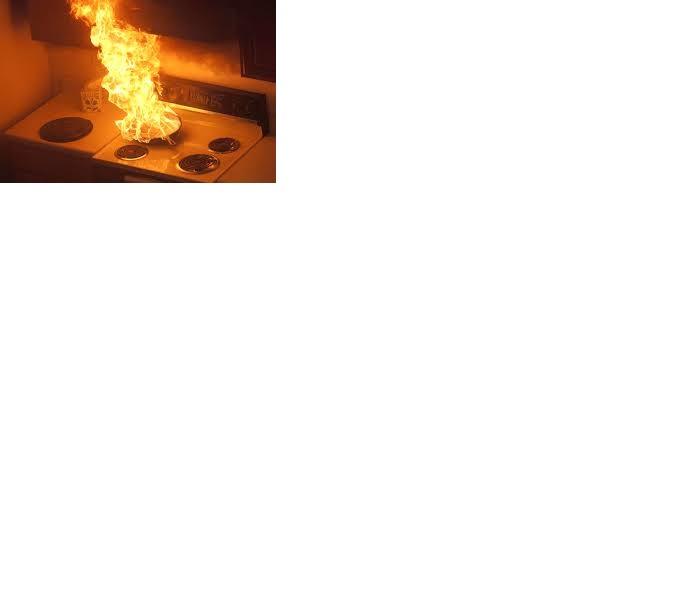 Which class of fire is this cooking fire?
Which class of fire is this cooking fire?
Not all fires are the same. They are caused by and thrive on different elements so, as a result, classes of fires came about. Classifications of fires are needed to determine how to extinguish them properly. You wouldn’t want to re-ignite or spread a fire by using the wrong type of extinguisher. Determining what class a fire is, is detrimental to using the proper equipment to extinguish it.
Class A involve ordinary combustibles such as paper, wood, plastics, cloth, trash and items that leave ash as a residue.
Class B fires are fueled by flammable or combustible liquids such as gasoline, propane, butane, paint and oil. Class B does not however include cooking oils or grease.
Class C are energized electrical fires which involve engines, transformers and appliances.
Class D fires are caused by combustible metals such as potassium, magnesium, titanium, sodium, and aluminum.
Class K fires are fueled by cooking oils, animal fat or grease. These normally occur in commercial kitchens.
In one of our previous blogs, you can read about the different types of extinguishers and which ones should be used for each specific class of fire.
Different Types of Fire Extinguishers
2/8/2016 (Permalink)
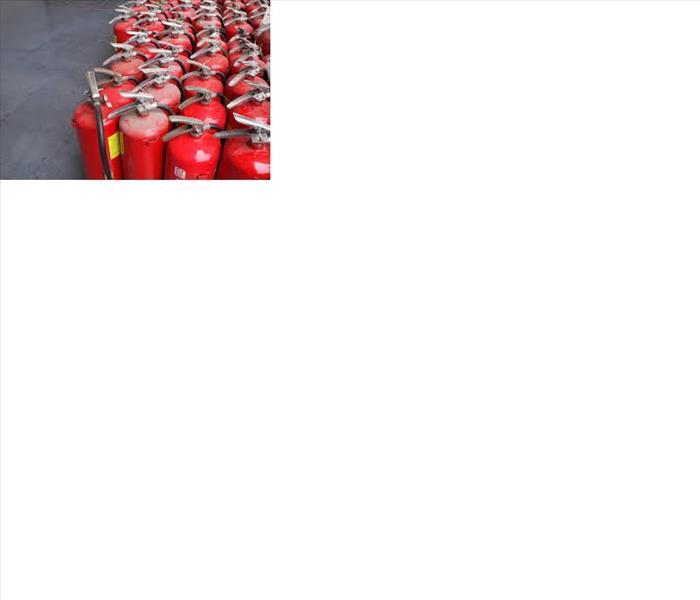 Fire Extinguishers.
Fire Extinguishers.
In order to understand why different fire extinguishers exist, first one needs to understand how a fire exists in general. Using the wrong extinguisher can even cause fires to re-ignite or spread in some cases.
The fire triangle is a model used to illustrate how fires start. The triangle includes 3 elements: oxygen, heat and fuel. Without these three elements, a fire cannot exist. Fire extinguishers are made to take away one or more of the three elements to cease the fire. Since there are different types of fuel involved in different fires, there are a variety of fire extinguishers one can use based on the source of the fire.
Dry Chemical is the most common fire extinguisher used today as it is effective on all types of fires and is most likely the one you have in your home or at your place of business. This type of extinguisher interrupts the chemical reaction by creating a barrier between the fuel source and the oxygen. This can be used on Class A, B and C fires.
Dry Powder extinguishers are similar to dry chemical in that they separate the fuel from the oxygen or remove the heat element of the fire. They are only used for combustible metal fires (Class D) and are ineffective on all other types of fires.
Clean Agent or Halogenated extinguishers use halon agents and halocarbon agents to interrupt the chemical reaction of the fire. Clean agent is mainly used for Class B and C however, it can be used on Class A as well. There are concerns regarding contamination when these are used which brings us to the next type of extinguisher…
Water Mist extinguishers are a newer development and extinguish the fire by taking away the heat component. These are much safer than clean agent extinguishers as no halocarbon is involved and are primarily for Class C but may be used on Class A fires as well.
Cartridge Operated Dry Chemical interrupt the chemical reaction of the three components in the fire triangle and create a barrier between the fuel and the oxygen components when used on Class A fires. This extinguisher is also effective on Class B and C fires.
Wet Chemical extinguishers are unique in that they remove the heat component and prevent re-ignition by creating a barrier. These extinguishers are used for Class K fires which typically involve deep fryers and commercial cooking operations but may also be used for Class A fires in commercial kitchens as well.
Water and Foam extinguishers not only take away the heat element but the foam separates the oxygen from the other elements. These are used in Class A fires only and should never be used in Class B or C. If used in a B or C classified fire, there is a risk of spreading and not extinguishing the fire.
Carbon Dioxide fire extinguishers remove the oxygen first and secondly, remove the heat with cold discharge. They can be used on Class B and C fires but aren’t normally effective on Class A fires.
Fire extinguishers exist for your safety but if used improperly, may cause more damage. Make sure you know what kind of fire extinguisher you have and what types of emergencies it should and should not be used for.
Top Causes of Home Fires
12/29/2015 (Permalink)
According to the National Fire Protection Association (NFPA), home fires are the leading cause of all fire deaths in the United States. For the most part, home fires are easily preventable.
Here are the top causes of home fires.
1.Cooking equipment. This may seem like a no brainer but believe it or not, cooking equipment is the leading cause of all home fires. Do not leave the stove or oven unattended while cooking. If you do need to leave the room, even for a second, make sure there are no flammable items such as dish rags,cookbooks, grease, curtains or paper products near your appliances. It’s always a good idea to keep a fire extinguisher in the kitchen as well, just in case.
2. Heating, the second most common cause of home fires. Most fires involving heaters are caused by portable space heaters. They may be nice and convenient but blankets, lint and other flammables can easily get caught in them. If you have to use a space heater, make sure there are no loose materials that could easily burn around it.
3. Smoking. Cigarette’s and their ashes can easily catch on curtains, bedding and clothing which can quickly result in an out of control fire. Many fires caused by smoking happen in the bedroom when someone falls asleep with a cigarette in their hand. If you must smoke, do so outside your home for the safety of everyone involved.
4. Electrical fires can happen for a variety of reasons. Here are the top four:
- Never remove the grounding plug on an appliance. Three pronged plugs exists on appliances that need extra power to operate. Get an electrician to install the proper outlet if you find this a problem in your home.
- Lamps and light fixtures. You should never install a bulb with wattage that is too high for a particular appliance. This will cause the bulb to overheat and in turn, catch the lampshade or other flammables nearby on fire. Another thing to avoid is covering your lamp shade or fixture with a cloth or paper. While it may look nice, it’s not worth the potential fire you may cause.
- Faulty cords and outdated appliances. Never use a cord that is worn or frayed. For this reason, you should also avoid running cords under rugs where they could become worn and go unnoticed for a long amount of time.
- Last but not least, outdated wiring. If your home is more than twenty years old, you may want to have a licensed electrician take a look at the wiring system. While replacing the system can get costly, it is nothing compared to a life or the belongings you could lose if the old wiring causes a fire.
Take the time to look around your house and ensure the safety of your friends and family by checking these common fire causes. Do you have a fire extinguisher? A working smoke alarm? How about a carbon monoxide detector? While it may seem tedious to check these items and think ahead, you will be able to sleep more soundly at night knowing you did.
Holiday Hazards
12/28/2015 (Permalink)
The holidays are a cheerful and exciting time but if you don't take certain precautions, they can result in tragedies for you and your family. Follow these simple tips to keep everything joyful and bright!
Christmas Tree Hazards
Be sure when picking out a tree, you pick one that is full of lots of green needles. Brown needles indicate the tree is too dry and dry trees are more likely to catch on fire. Another good test is to see if the branches snap easily. A healthy tree's branches will bend and be tough to break.
When you put your tree up, be sure to water it every day to keep it from drying out. When the needles start falling off at a rapid rate or start to turn brown, it's probably time to get rid of the tree.
For all of you artificial tree people out there, check to make sure the tree you have or the one you are buying is labeled fire resistant or flame retardant.
Holiday Lights
Before using lights indoor or outdoors, check the label to make sure you are using them in the right location. There will be an indictor on the packing and the cord itself telling you if it is safe for indoor or outdoor use.
Whether the lights are brand new or old and faithful strands, check for frayed wires and shortages. If there are any, throw these strands out. For broken light bulbs, unplug the light strand and replace the bulb with one of the proper wattage for that strand.
When placing lights on the tree, as mentioned in the previous section, if the tree is watered enough there shouldn't be any problems.
Never overload your circuit! If you need to use more than two plugs in an outlet, use a surge protector instead of many different extension cords.
Candles
Many people use candles during the holidays to create ambience. Just make sure candles are several feet away from any flammables. Never leave a candle burning when you leave your home; you never know what could happen while you are gone.
Cooking
If you are like most people, you probably do a little more cooking than usual around the holidays. It never hurts to review simple cooking safety tips. Do not leave the oven or stove unattended. Make sure you clear any flammable materials away from heat sources such as pot holders and curtains. It's also not a bad idea to keep a fire extinguisher under the kitchen sink in case of an emergency. Last but not least, make sure you don't have any loose hanging clothing on while you are cooking.
Stay safe this holiday season and happy holidays!
 Fire damage and soot removal are cornerstones of SERVPRO's recovery for North Syracuse homes and businesses.
Fire damage and soot removal are cornerstones of SERVPRO's recovery for North Syracuse homes and businesses.






 24/7 Emergency Service
24/7 Emergency Service














